NADmagNADmag
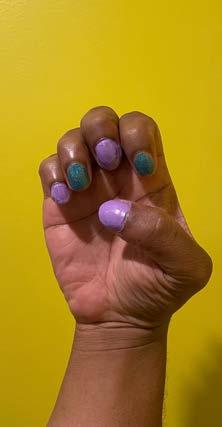
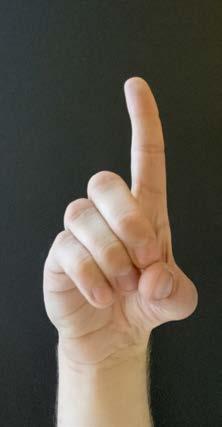

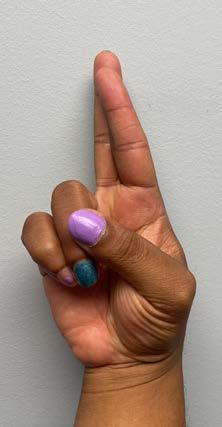
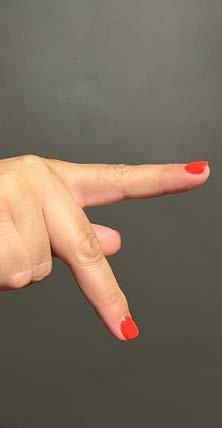
1 NADmag | Fall 2022
Fall 2022 | Volume 22, Issue 1
A Publication of the National Association of the Deaf
ABOUT THE ©2022, is published by the NAD (USA), and is sent as a national membership benefit.
For membership information, contact Member/Donor Relations at nad.info@nad.org or complete the contact form at: nad.org/contactus
Subscriptions: Libraries, schools, and similar institutions may subscribe to NADmag. For more information, complete the contact form at nad. org/contactus
Requests for Permission: Materials in this publication may not be reproduced in any form without written permission. Complete the contact form at nad. org/contactus or email nad.info@nad.org
Advertise in NADmag: For more information, go to nad.org/advertise or email nad.info@nad.org
Publication of an advertisement in the NADmag does not imply NAD endorsement of a product or service. The NADmag is not responsible for advertisement contents. The National Association of the Deaf and the NADmag do not endorse or recommend any article, product, service, opinion, advice, statement, or other information or content expressed by third party authors. The views and opinions of such third party authors who have submitted articles to the NADmag belong to them and do not reflect the views of the National Association of the Deaf.
ABOUT THE NAD
The National Association of the Deaf (NAD) was established in 1880 by deaf leaders who believed in the right of the American deaf community to use sign language, to congregate on issues important to them, and to have its interests represented at the national level. These beliefs remain true to this day, with American Sign Language as a core value. As a nonprofit federation, the mission of the NAD is to preserve, protect, and promote the civil, human, and linguistic rights of deaf and hard of hearing individuals in the United States of America. The advocacy scope of the NAD is broad, covering the breadth of a lifetime and impacting future generations in the areas of early intervention, education, employment, health care, technology, telecommunications, youth leadership, and more.
For more information, visit nad.org
ABOUT DESCRIBED & CAPTIONED
1447 E. Main Street, Spartanburg, SC 29307 800.237.6213 / 800.237.6819 TTY 800.538.5636 F info@dcmp.org / dcmp.org The DCMP is funded by the U.S. Department of
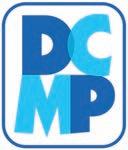
and administered by the NAD.
NATIONAL ASSOCIATION OF THE DEAF 8630 Fenton Street, Ste. 820, Silver Spring MD 20910 301.587.1788 / 301.587.1789 TTY nad.info@nad.org / CFC Number: 10356
MISSION STATEMENT
To preserve, protect, and promote the civil, human, and linguistic rights of deaf and hard of hearing individuals in the United States of America.
CONTACT / LEARN MORE
To contact the Board of Directors, complete the contact form at nad.org/contactus. For information about the Board, visit nad.org/board Guests
2
Topher
Ariel
melissa
Gallaudet
Bee
Stephanie
Poorna
Jacob Leffler Rainbow
Lisa
Oliver Stabbe
Ávila
Baker-Gibbs
kelley colibrí
University
Gehman
Hakulin
Kushalnagar
Alliance of the Deaf
Rose
The Research Staff
MEDIA
and Captioned Media Program
EDITORIAL TEAM Publisher NAD Chief Executive Officer Howard A. Rosenblum Editor in Chief Lizzie Bloom Editor Anita Farb Advertising / Sales Donna Morris Desktop Publishing Jill O’Leske, Graphic Designer impactdesign.biz President Jenny Buechner Vice President Stephanie Hakulin Secretary Milmaglyn Morales Treasurer Michelle Cline Region I Jacob Leffler Nicholas Lalanne Region II Linsay Darnall, Jr. Kevin Ryan Region III Michael Deuel Lisa Rose Region IV James “Dino” Christianson Laura Kim Affiliates Tyese Wright Appointed Vyron Kinson Kim Thornsberry
PROGRAM Described
Education
THE BOARD
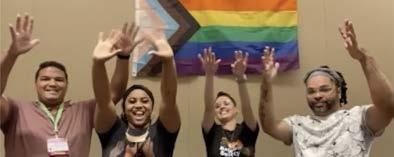



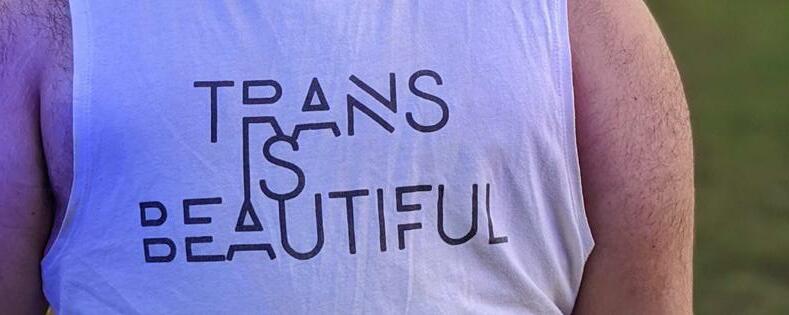
3 NADmag | Fall 2022 RECURRING FEATURES From the President // Jenny Buechner From the CEO // Howard A. Rosenblum School Spotlight // Youth Leadership Camp Builders (Staff) Deaf Culture Today // Lizzie Bloom Donor List In Memoriam 5 7 10 11 45 51 Deaf LGBTQIA2S+ Leaders in Our Community Jacob Leffler and Lisa Rose History Behind Rainbow Alliance of the Deaf Rainbow Alliance of the Deaf Why Are Queer Interpreters Important? Topher Ávila Pronouns: Why Is It Important to Normalize Pronouns? Bee Gehman and melissa kelley colibrí Take-aways: Intersecting LGBTQIA2S+ Identities Stephanie Hakulin and Lizzie Bloom Parallel Needs in Supporting Trans Deaf Communities Oliver Stabbe Healthcare and the Deaf LGBTQ Community Poorna Kushalnagar Deaf Humans of PRIDE Ariel Baker-Gibbs 15 19 23 25 28 32 35 39 25 32 5 7 19
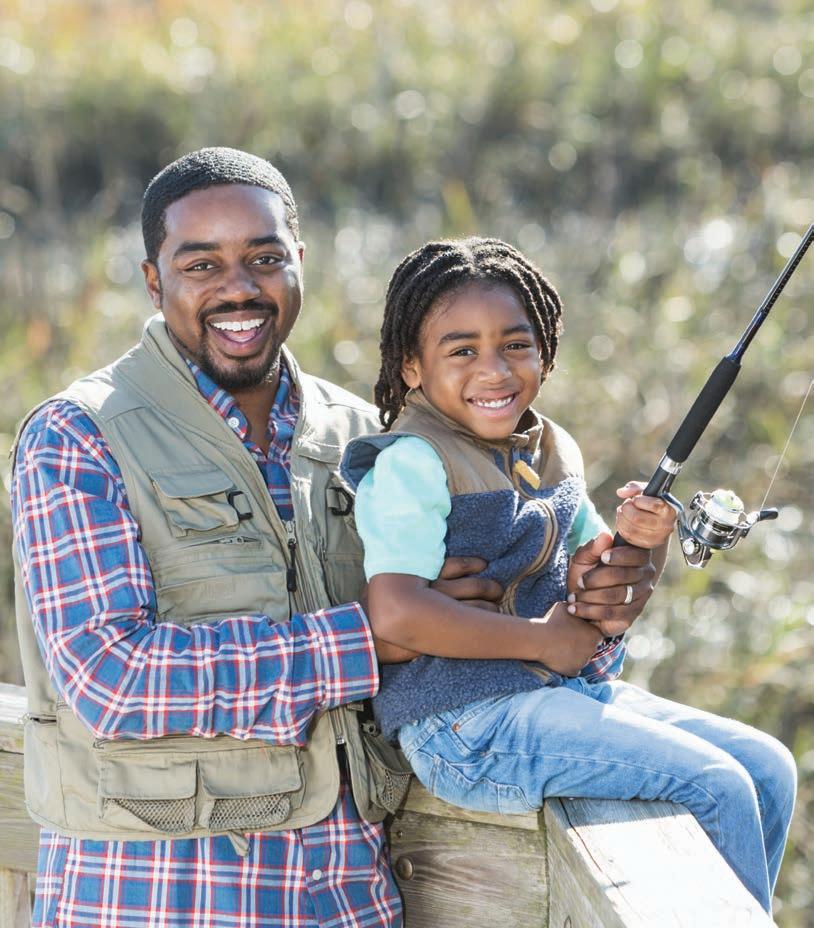
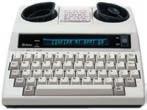
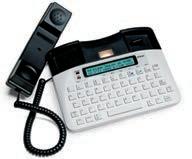
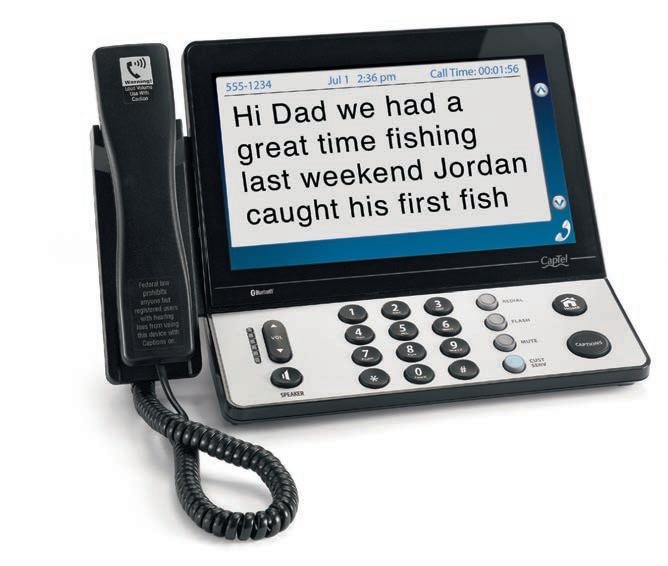
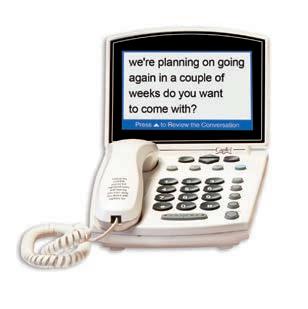
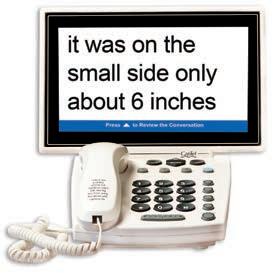
4 CONNECTING MADE EASY Whether it’s voice or text, from across the street or across the country, you can rely on Ultratec technology to keep you connected. www.ultratec.com 1-800-482-2424 (V/TTY) service@ultratec.com TTYs & captioned telephones CAPTEL ® CAPTIONED TELEPHONES THAT FIT YOUR LIFESTYLE . FEDERAL LAW PROHIBITS ANYONE BUT REGISTERED USERS WITH HEARING LOSS FROM USING INTERNET PROTOCOL (IP) CAPTIONED TELEPHONES WITH THE CAPTIONS TURNED ON. IP Captioned Telephone Service may use a live operator. The operator generates captions of what the other party to the call says. These captions are then sent to your phone. There is a cost for each minute of captions generated, paid from a federally administered fund. No cost is passed on to the CapTel user for using the service. CapTel captioning service is intended exclusively for individuals with hearing loss. CapTel® is a registered trademark of Ultratec, Inc. The Bluetooth® word mark and logos are registered trademarks owned by Bluetooth SIG, Inc. and any use of such marks by Ultratec, Inc. is under license. (v2.6 10-19) CapTel 2400i includes Bluetooth® wireless technology Low Vision Model CapTel 880i
Ongoing Initiatives for Learning and Inclusion
BY JENNY BUECHNER (she, hers)
The NAD welcomes all people, including folks who identify as or are a part of the LGBTQIA2S+ community. In order to serve all communities including the LGBTQIA2S+ communities, we must learn about each other. The NAD has taken initiatives over the years to ensure that there are opportunities for learning such as training for the NAD Board, training for the Delegates at the 2022 NAD Council of Representatives, 2022 NAD conference attendees, and the community at large.
In April of 2022, the NAD Board received training specifically on pronoun usage, the recent legislation that passed in Florida that affects the LGBTQIA2S+ community, and what the NAD needs to consider in terms of creating an affirmative space. The Board had the opportunity to discuss the importance of respecting the pronoun(s) people use, and to include pronouns in our introductions. The Board also had
the opportunity to discuss ideas on how to create an affirming space for our LGBTQIA2S+ members and conference attendees in Orlando, Florida. This led to the conference planning committee to create the NAD@Night: Unity event on June 30th.
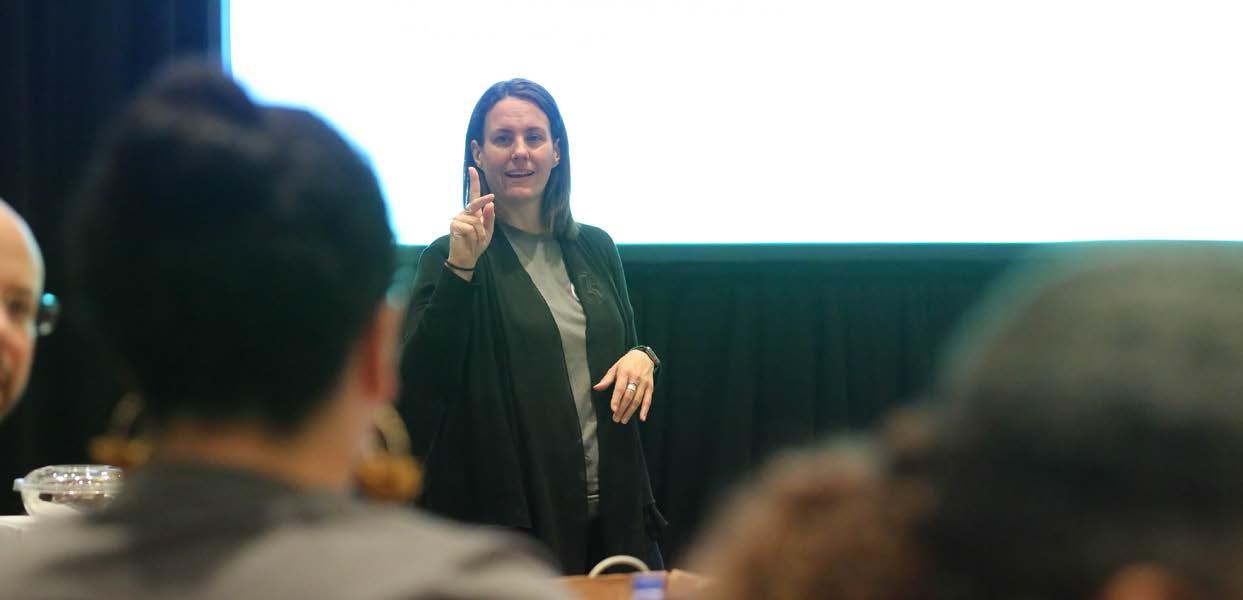
During the NAD Conference, several things occurred to demonstrate our commitment to ensuring our LGBTQIA2S+ members are welcome and have a sense of belonging within the NAD.
At the NAD@Night: Unity event, Akilah English and Derrick Behm-Josa spoke about the Anti-Critical Race Theory and “Don’t Say Gay” legislations that had recently passed in Florida. This allowed conference attendees to better understand the impact of those two legislations upon community members including their family, friends, and loved ones.
Akilah and Derrick also indicated that Florida wasn’t
5 NADmag | Fall 2022
THE PRESIDENT
FROM
Newly appointed NAD President Jenny Buechner greets attendees at the 56th Biennial NAD conference in Orlando, Fla., June 30-July 4, 2022.
FROM THE PRESIDENT
the only state impacted by such laws as more and more states are facing similar situations.
Throughout the conference, some attendees bought 2022 Biennial Conference shirts with the progressive colors around the NAD logo, and those shirts actually sold out! Many attendees asked where they could get the shirts, demonstrating their support to the LGBTQIA2S+ community. For the first time ever, we had “Spirit Week” with daily themes for people to dress up for and on July 1st, individuals were encouraged to wear LGBTQIA2S+-affirming attire, in addition to BIPOC-affirming attire on July 2nd, and Deaf-affirming attire on July 3rd.
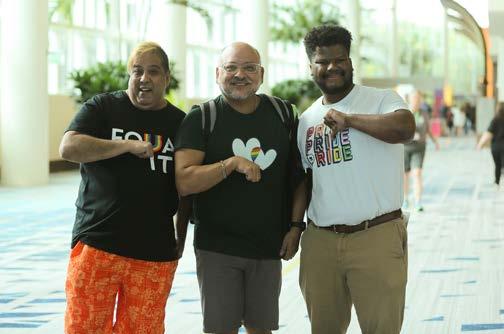
On July 1st, the LGBT Section hosted its biennial luncheon, and Hunta Williams was its keynote speaker. Hundreds of conference attendees opened up their hearts and minds as they learned about Hunta’s journey. Also, throughout the conference, the NAD had lounges for our BIPOC, DeafBlind, and LGBTQIA2S+ attendees to have a space to retreat to, to take a pause, network with each other, and just be.
Prior to the conference, the Delegates of the 2022 NAD Council of Representatives had the opportunity to learn about gender identities and pronouns in advance of the conference.

The NAD hosted a series of webinars entitled “Real Talk, Good Action”, which primarily focused on issues regarding racism, and is available to anyone in the community through live sessions as well as on our website under “Events”. In June of 2022, the series focused on Intersecting LGBTQIA2S+ Identities and Anti-Racism Work.
Our initiatives only scratch the surface. We continue to put in the work so all folks who identify as LGBTQIA2S+ will feel welcome at the NAD. We know we are not there yet, and the work does not end here. We are committed to continuing to ensure that our members are welcome and have representation within the NAD.
NADly yours, Jenny Buechner
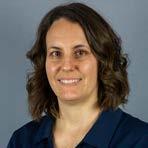
6
Jenny Buechner (she/hers) has been on the NAD Board since 2013 and now serves as President for 2022-2024.
We are committed to continuing to ensure that our members are welcome and have representation within the NAD.
The NAD Board of 2022-2024 perform the Oath at the 56th Biennial NAD Conference.
NAD conference attendees show support to the LGBTQIA2S+ community during spirit week.
FROM THE CEO
ENGAGING FOR EQUALITY: Civil Rights for All
BY HOWARD A. ROSENBLUM (he, him)
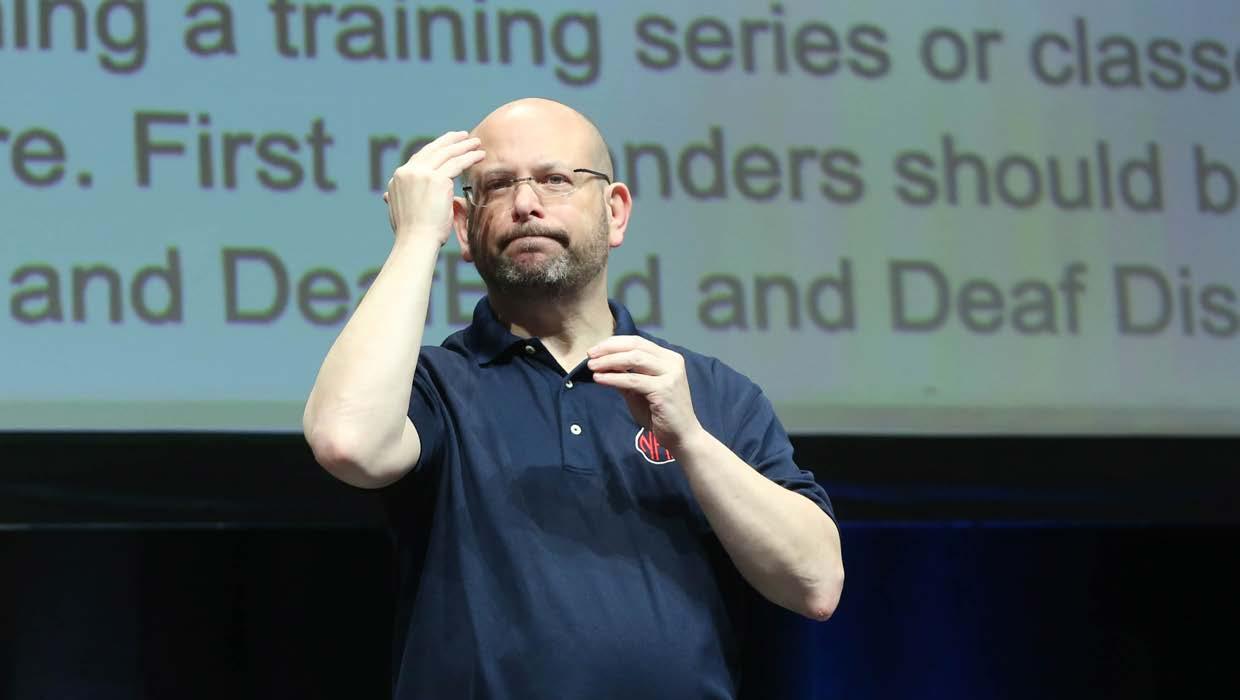
Recent political events and Supreme Court decisions that have upended a long tradition of respect for individuals’ civil rights have been deeply unsettling and profoundly disturbing. These changes go beyond political parties and goes to the core of what America represents in terms of individual freedoms.
The United States has long been considered the great Democracy experiment and has inspired the advent of more democracies and movements towards freedom across many countries. Despite these advancements, this country has a long history of oppression against individuals on the bases of race, color, gender, religion, national origin, disability, sexual orientation and many other personal identities. Movement
towards protecting all such personal identities has often moved too slowly and has ignored the violence and hatred brought upon too many.
In recent decades, there has been some progress including marriage rights for inter-racial couples and LGBTQIA2S+. However, recent political, judicial, and legislative events have set us back, including devastating results that breed more dangerous decisions and laws threatening to further upend our ability to respect each other.
Regardless of your political beliefs, it is imperative that all of us protect each other’s civil rights. To paraphrase
7 NADmag | Fall 2022
Howard presents at the Council of Representatives during the 56th Biennial NAD Conference.
what many wise people have said before: the loss of any person’s civil rights threatens everyone’s civil rights.
The National Association of the Deaf stands with all civil rights groups to condemn any actions or decisions that deny civil rights to any individual. The reason for our support for all rights is simple and goes beyond being Deaf. People have been denied rights just for being Deaf, DeafBlind, DeafDisabled, Hard of Hearing or Late-Deafened, as well as for having other identities in addition to those. For example, not too long ago in this country, there were discussions about not allowing Deaf people to marry each other. Deaf people also were not allowed to work in the government and in many industries. Deaf people were not allowed to drive. Deaf people were not allowed to own property.
These prohibitions against Deaf, DeafBlind, DeafDisabled, Hard of Hearing, and LateDeaf people cannot compare to the oppression, discrimination, and violence experienced by Black, Indigenous, People of Color (BIPOC), LGBTQIA2S+, religious minorities, and other marginalized groups. But it is worth remembering that if their civil rights are taken away, then everyone’s civil rights are at risk including those of Deaf people.
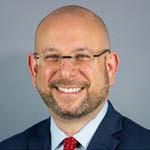
We cannot remain silent about the harms caused to other people by arguing that the NAD should only focus on “Deaf” issues. There are Deaf people within every group of personal identity, and harm to any of them is harm to all of us. Moreover, all civil rights are connected to each other, and failing to protect the rights of one group often leads to the loss of rights for every group.
The NAD seeks equality for all Deaf, DeafBlind, DeafDisabled, Hard of Hearing, and Late-Deaf, including for those who are BIPOC, LGBTQIA2S+, religious minorities, and those from other marginalized groups. We ask that all members of the community stand together as we learn from each other and work to dismantle every form of “ism” to ensure that everyone’s civil rights are respected, supported, and protected.

8
FROM THE CEO
We cannot remain silent about the harms caused to other people by arguing that the NAD should only focus on “Deaf” issues.
Howard A. Rosenblum, Esq. (he/him) has served as the NAD Chief Executive Officer since 2011.
Howard and outgoing president Melissa Draganac-Hawk pose for the camera at the 56th Biennial NAD conference in Orlando, Fla.
Why are pronouns important?

YOUTH LEADERSHIP CAMP BUILDERS (STAFF)
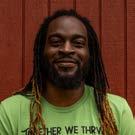
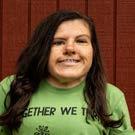
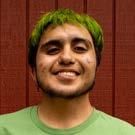
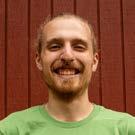


Pronouns are important because people can show their identity and create an inclusive safe environment.
Using appropriate pronouns is important for people because it’s showing them respect and allows gender identity in a safe environment. The pronoun can create a more welcoming space for people of all genders and makes them feel valued and equal.
Pronouns are important because it honors a person’s identity. Using pronouns values people of different genders. It allows everyone space to be recognized and respected and feel equal.
Using a fellow peer’s respective pronouns is one of many ways to exhibit your recognition and honor for those around you.
BRIDGET BERRIGAN
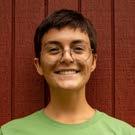
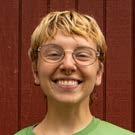
Knowing and using a person’s appropriate pronouns makes people feel more respected and equally valued and declares their gender identity.
Pronouns identify us therefore appropriate references are needed.
Pronouns are important to the individual and valid regardless of your decisions or opinions.
Using pronouns appropriately is a simple way to demonstrate respect for the identities of those around you.
Because we all deserve personal autonomy and the respect that comes along with that.
9 NADmag | Fall 2022
DHRUVESH PATEL He/Him
LENNETTE BUTLER She/Her
JETT KELLY He/Him
TYLER MENDEZ-GUERRERO They/Them
SARAH CASTOR She/Her
JIMEL BRIGHTLY He/Him
JAI DORTCH She/Her
She/Her
GRACE LESTER She/Her
SCHOOL SPOTLIGHT

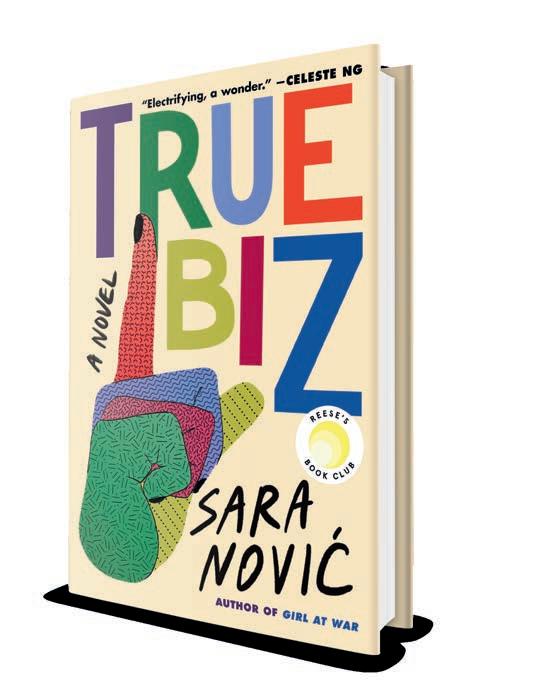
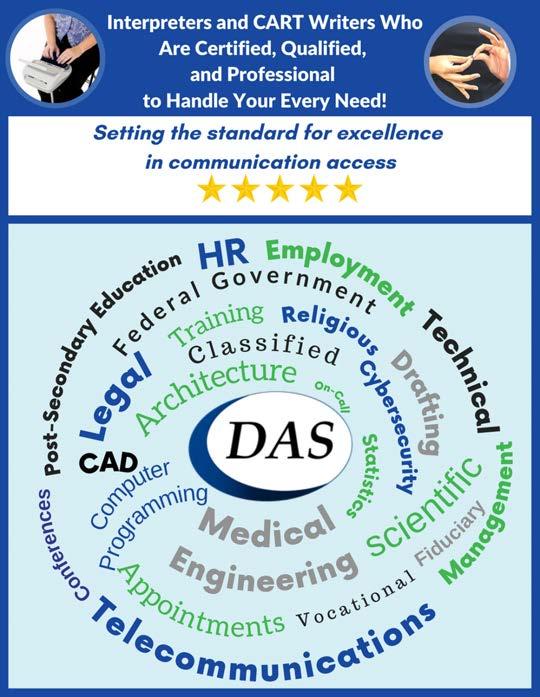

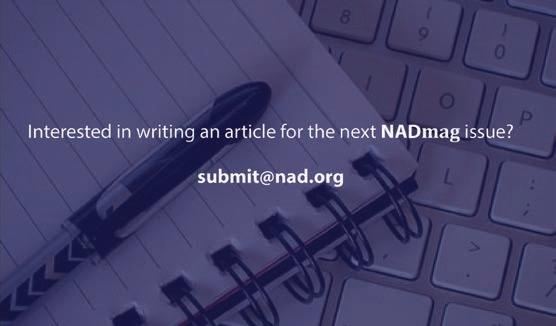
Reese’s Book Club Pick FIND YOUR PEOPLE. FIND YOUR LANGUAGE. FIND YOURSELF. Available Now • sara-novic.com
Q&A with the Deaf Queer Resource Center

What is the Deaf Queer Resource Center and what are some of the services that DQRC provides?

The Deaf Queer Resource Center (DQRC) is a Deaf QTPOC-founded and led national 501(c)(3) nonprofit organization based in San Francisco. DQRC is an organization that is committed to social justice and works to support, inform, empower and bring more visibility to and awareness about multiply marginalized Deaf LGBTQ communities.
Some of the many services DQRC provides include information and referrals, peer support, support groups, coming out support, educational workshops, advocacy, anti-racism and social justice trainings, allyship building, transgender trainings, and accessibility trainings. DQRC also has both Queer and Trans youth support groups and offers youth scholarships. The organization also works to preserve Deaf LGBTQ histories.
How did the Deaf Queer Resource Center come into existence?
Back in the early 1990s, San Francisco became home to the very first center for Deaf LGBTQ people called the Deaf Gay & Lesbian Center (DGLC). DGLC came into existence via a grant from the United Way of the Bay Area that Deaf Counseling Advocacy & Referral Agency (DCARA) applied for.
Drago Rentería, a Deaf LGBTQ leader and activist who was a college student at the time, was tapped to run the newly formed center not long after its founding. One of the first things he did was raise funds to relocate the center from the Tenderloin to the Castro District.
While working at DGLC, Drago learned of many Deaf LGBTQ people that resided outside of the Bay Area who desperately needed support and services.

11 NADmag | Fall 2022
AN INTERVIEW BY LIZZIE BLOOM (she, hers)
DEAF CULTURE TODAY DEAF CULTURE TODAY
Most Deaf LGBTQ people residing in small towns and cities, for example, had virtually no support systems of any kind and nowhere to turn to for support. Not many LGBTQ centers and programs existed nationwide at the time and of those that did, virtually none provided language access.

Due to grant restrictions, Drago was told that DGLC could not provide services to people who resided outside of the Bay Area unless they dropped by the center in-person. One reason for this was that, unlike today, long distance phone calls were expensive to make, especially TTY calls. The mobile phones and the videophone technology that we enjoy today did not yet exist.
Drago was frustrated by this limitation. At a time when homophobia and transphobia were widely rampant (much more so than today) and being LGBTQ was still considered to be a mental illness by many and something that most people believed should be hidden, he knew that the lack of support could be death sentence for many, especially for struggling Deaf LGBTQ youth.
With the Internet just starting to take off, Drago decided to see how he could utilize this new technology to reach, support, and bring together more of his Deaf LGBTQ communities on a national level. He spent his days working at DGLC
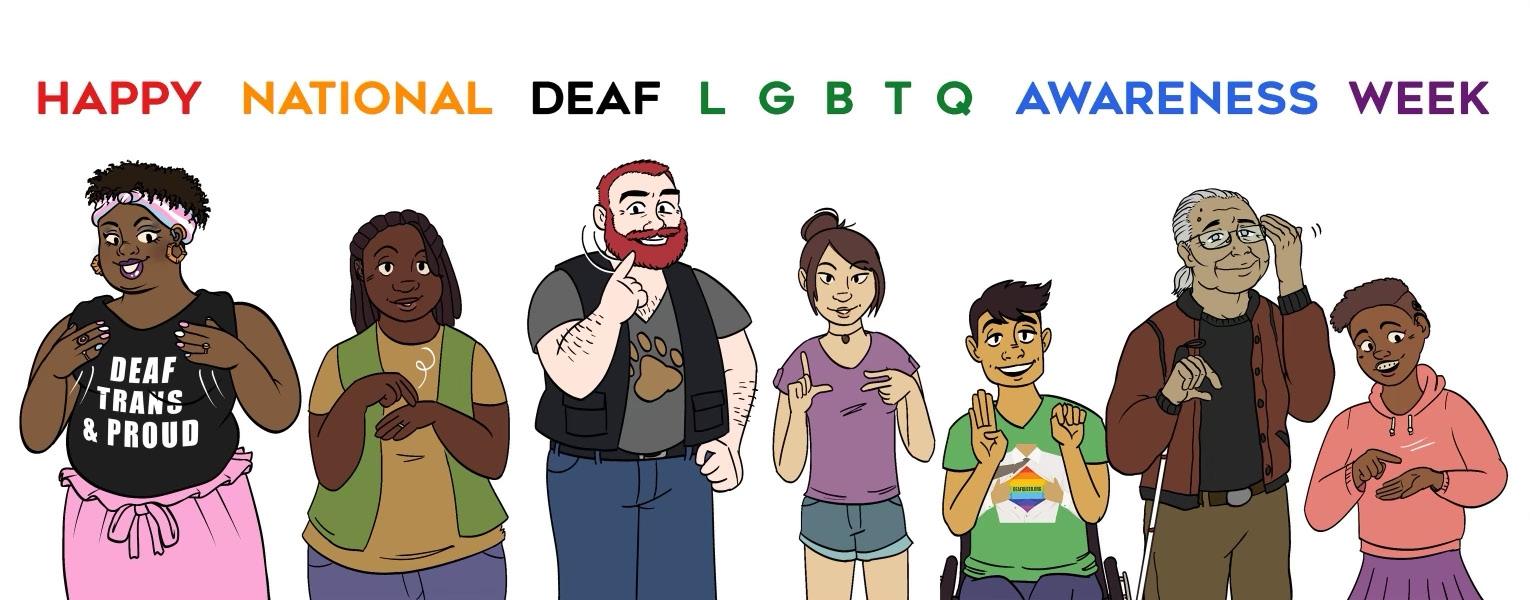
and his nights learning all he could about this new technology, the Internet. There were no books yet on how to create websites and despite not having a computer background, Drago taught himself HTML and Perl/CGI directly from static pages on the Internet for the sole purpose of creating what would become the Deaf Queer Resource Center’s website. He visualized a virtual online community center accessible to all who had Internet access.
On September 1st, 1995, Drago made that dream a reality and officially launched DQRC online. It would become one of the first three major deaf websites on the Internet at the time (the other two were Deaf World Web and the Deaf Resources
12
CULTURE
DEAF
TODAY
National Deaf LGBTQ Awareness Week logo. Designed by Deaf transgender artist Carlisle Robinson.
Drago Rentería, pictured here in 2006, is known as the ‘Father of Deaf Queer Activism’. He is a long-time Deaf LGBTQ leader and social justice activist who founded the DQRC.
Library). And not only would the website serve to support and bring together Deaf LGBTQ communities nationwide but it would also serve to promote positive Deaf LGBTQ visibility and pride, something that few of our straight deaf and hearing counterparts had witnessed before that time. Back then, being LGBTQ wasn’t something that most people thought one should be proud of. DQRC was on the frontlines and its leadership, presence, visibility and activism helped change that narrative. Google would launch three years later on September 4th, 1998. And the rest, as they say, is history.
Why do you use the word ‘queer’ in your organization title?
We love the word ‘queer’ and use it proudly.
The word ‘queer’ has traditionally been used as a pejorative that straight people would spit and hurl at us as a way to hurt us. In the early 90s, a radical, direct-action organization called Queer Nation was formed. The organization believed in intersectional activism, anti-assimilation and taking back words that were once used to harm us and turning them into words of pride and empowerment.
Drago was involved with Queer Nation back in the early 90s. When he decided to form the Deaf Queer Resource Center, it was only natural that he’d want to use the word ‘Queer’ in the organization’s title. Little did he know that this would make DQRC one of the very first organizations in the world to do so. Not everyone was thrilled about this word choice, however, and there was some backlash initially. DQRC received angry emails and letters from LGBT community members, both deaf and hearing, who were extremely displeased regarding the word’s usage. DQRC remained steadfast in its belief that taking back the word was something it wanted to do and continued to do so. Fast forward to today, the word
queer is now widely used and embraced. There are even Queer Studies departments on many college campuses.
It’s important to acknowledge that the word queer embodies both pain and empowerment within our LGBTQ communities. Many of our LGBT elders still cringe whenever they see or hear the word used today and understandably so.

As long-time activists, we see the word as a badge of honor. It is a word we have reclaimed with pride. The Queer Nation mantra, “We’re here. We’re queer. Get used to it!” has pretty much been a mantra we’ve embraced and incorporated since DQRC’s inception and is reflected in our long-standing and ongoing activism work.
We also love the word queer because it’s an inclusive, unifying umbrella term that honors our many complex sexual and gender identities. There is no perfect acronym to encapsulate our extremely diverse
13 NADmag | Fall 2022
Some members of DQRC’s Deaf Trans Youth support group meet on Zoom.
“DQRC has worked to utilize these new technologies to provide services and stay connected to our Deaf LGBTQ communities nationwide.”
communities. People try with what seems like a never-ending alphabetical string of letters, the latest being LGBTQIA2S, but the problem with these acronyms is that there are always people who are left out and others who feel their identities should not be included. And that’s the beauty of the word ‘queer’, it encompasses all identities that are not exclusively heterosexual or cisgender.
That said, it’s always important to ask people how they wish to be identified and honor those chosen terms for those individuals.
With the rapid changing technology we have, how does DQRC stay current and engaged with the community?
It’s been fascinating to watch how technology has rapidly evolved since DQRC was founded back in 1995. DQRC has worked to utilize these new technologies to provide services and stay connected to our Deaf LGBTQ communities nationwide. We especially love being able to provide workshops and support groups through new technologies such as Zoom.
The advent of social media has especially been a game changer for us in terms of allowing us to reach and interact with more members of our Deaf LGBTQ communities on a national and international level than ever before.
For those who use social media, if you don’t currently do so, we invite you to connect with us on Facebook, Instagram, Twitter, TikTok and YouTube at: @deafqueer.
What’s one important event during the year that we should know to support and celebrate in the Deaf Queer communities?
National Deaf LGBTQ Awareness Week! It takes place annually in April. This week is about being proudly visible, celebrating our many multiple
marginalized identities and most importantly, inspiring and uplifting our Deaf LGBTQ youth.
We want every single one of our youth to grow up knowing that they aren’t alone, that they have role models and vibrant Deaf LGBTQ communities waiting to support and embrace them with open arms.
Share a goal that you hope to accomplish in five years.
Since its founding in 1995, DQRC has been an entirely volunteer-run organization. One of our current goals is to secure enough funding to hire paid staff, especially a Youth Coordinator and a fulltime Executive Director to continue the critical work we do for our Deaf LGBTQ communities. There is only so much that DQRC can accomplish on volunteer-basis without steady and stable funding.
Any advice for deaf queer and trans youth who may read this article?
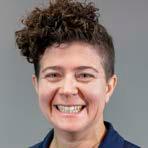
Know that you are not alone and that you are deeply loved. DQRC has a youth program. Reach out and we will connect you to other amazing Deaf Queer and Trans youth just like yourself.
How can we support DQRC?
There are many ways you can support DQRC. If you have funds to spare, please donate. Every dollar truly counts. Secondly, if you have time, volunteer. You can also support us by re-sharing our events and other social media content to help us reach more people. Thank you!
14 DEAF CULTURE TODAY
Lizzie Bloom (she/hers) is the Director of Engagement at the NAD.
“It’s always important to ask people how they wish to be identified and honor those chosen terms for those individuals.”
Deaf LGBTQIA2S+ Leaders in Our Community
As we celebrate LGBTQIA2S+, there are so many people who contribute to our community on different levels, including State Associations and Affiliates. With our own individual journey as a LGBTQIA2S+ leader for the community, we do experience struggles and frustrations. We asked four LGBTQIA2S+ leaders to share their experiences and wisdom.
BY JACOB LEFFLER (he, him) AND LISA ROSE (she, hers)
How did you become interested as a leader in your organization?
KA I have been involved with different organizations since college days from local to state to regional. Currently, I’m the president of the Washington State Association of the Deaf (WSAD).

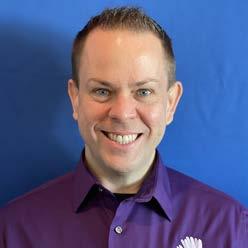

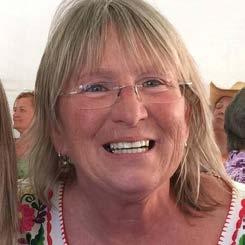
SL I joined Jr. Illinois Association of the Deaf (IAD) during my high school years when our club advisor saw leadership potential in me. From there, I learned how Jr. IAD, IAD, and the NAD all worked together. Fast forward to my RIT years in New York, I found out about the Empire State Association of the Deaf (ESAD) and met many wonderful older leaders and mentors who encouraged me to continue my leadership journey through campus community activities, local groups, and statewide organizations. I’m very involved with the Empire State Association of the Deaf.
CL I am a California native, I have lived in New York, North Carolina, Washington and now here in Oregon. My past profession with the telecommunication industry allowed me to travel to many expos through my 10-year with them. I was able to see a wealth of resources, information, and services available in diverse regions. When I arrived in Oregon nearly 10 years ago, I was in utmost cultural shock that the resource availability in this state was nonexistent. I met with about eight past Oregon Association of the Deaf presidents to learn some history, back stories, and also to listen. This prompted me to roll up my sleeves and start getting involved with the Oregon legislature. During the 2015 session – I was told that I needed to present data, so I asked for funding to conduct a community-based Needs Assessment (CNA). The CNA report was submitted in the 2017 session, and they implied that there was no funding available. As
15 NADmag | Fall 2022
FEATURE
KAREN ATWOOD (KA) (she, hers)
STEVE LOVI (SL) (he, him)
CHAD LUDWIG (CL) (he, him)
HUNTA WILLIAMS (HW) (he, him, they)
a result, I founded Bridges Oregon to use the data to seek grants.
HW It happened naturally. I went to different organizations’ meetings and activities to watch how they lead and learn what their leadership style is like. I was involved with the Virginia Association of the Deaf as a Delegate at the 56th Biennial NAD Conference in Orlando, Florida this year.
As a leader, what was your experience when you came out as a LGBTQIA2S+?
KA Being who I am, I don’t believe in labels or pronouns but I will listen and respect each person’s life preferences.
SL It was a positive experience in being a gay deaf community leader. I worked with both Deaf and Hearing non- LGBTQIA2S+ organizations that were very supportive to me as an out gay person. Leadership should not be based on one’s sexual identity.
CL I came out in October 1992 while I was a student at NTID/RIT and I led a campus-wide movement to tolerate and accept the LGBTQ community. I was featured in NTID Focus magazine shortly after, about the movement and this pushed for policy change. The university finally recognized domestic partnership, access to health insurance, and much more. This was the starting point of my leadership awakening when I realized the power of leadership and how it influences change – that experience stayed with me since. NTID created a safe and supportive space for students’ abilities to blossom and I am forever grateful.
HW It was tough, as a leader coming out as a LGBTQIA2S+. It was important to have a support system.
How do you make your organization more inclusive for LGBTQIA2S+ members?
KA Treat them the same you would treat everyone else. WSAD welcome LGBTQIA2S+ folks!
SL ESAD continues to work on reaching out to diverse groups, including the LGBTQIA2S+ community through events and advocacy activities. Recently, ESAD supported Pride month in June by posting on Facebook. There are a number of allies on the ESAD board as well as two openly gay board members.
CL For starters, I am cisgender, Deaf, gay, and male. We work with several contractors who identify as part of the LGBTQIA2S+ spectrum. Bridges Oregon also has a policy statement that ensures the agency recognizes and honors all walks of life with diverse identities, intersectionality, and pronouns.
HW It is very important for organizations to listen to members and bring them in. If there is a lack of diversity within the organization, this means more training is needed to educate members. As a leader, you need to be inclusive and promote civic engagement.
How can others be more welcoming towards LGBTQIA2S+ folks?
KA WSAD usually provides workshops and we invite LGBTQIA2S+ folks to share their stories. WSAD started hosting Zoom Deaf Chats since the pandemic started.
SL Sponsoring community events or hosting “themed’’ small parties with a large mixed group of people from all walks of life is one way to engage straight folks in becoming more understanding and welcoming. Helping to answer straight people’s inquiries or questions about the LGBTQIA2S+ community in a casual setting can sometimes help break down misleading perceptions or misperceived
16 FEATURE
DEAF LGBTQIA2S+ LEADERS IN
thoughts. Having such conversations may help straight folks be more open and welcoming.
CL A requirement of Bridges Oregon is to attend ongoing training on bias, oppression, hate, social justice, as well as other training throughout their employment with this agency.
HW Be open. Start with civic engagement. Listen and include LGBTQIA2S+ people. Share tools and resources. Use LGBTQIA2S+ people to provide training and workshops.
How can you support other marginalized groups within the LGBTQIA2S+ community?
KA Be present, listen, include them in activities, invite them. They are just like everyone else that wants to be included.
SL One of the most important ways to show support and create lasting change is to seek out and maintain a diverse group of board members as well as organization members that reflect your community or state’s marginalized groups. Providing a safe and welcoming environment along with events or activities that attract marginalized people is key to building a well-represented organization.
CL The staff and board at Bridges Oregon have a regular conversation on selected marginalized topics in every meeting to continue our unpacking, recognizing the need, being more aware, and be part of the change. Eventually, I want to introduce transformative and retroactive justice in our road map – with transformative and retroactive justice lens, we can challenge this agency while working with every marginalized member in our community. It’s also important to have diverse and intersectional representation on the board.
HW As a Black person, my people have been marginalized for many years. For those marginalized groups, I will always support them and help them to
form a different small LGBTQIA2S+ communities such as Black, Latinx, Indigenous, and People of Color. We must lift them up and work with them.
How can organizations share their resources with the LGBTQIA2S+ community?
KA By contacting them and inviting them. WSAD lists different Deaf LGBTQIA2S+ events and activities to share with the community.
CL By sharing State Association websites and Facebook pages as well as other social media platforms with state or community LGBTQIA2S+ organizations. Also, State Associations can consider co-hosting advocacy events and social gatherings with LGBTQIA2S+ groups.
HW Some organizations use Facebook groups, Instagram, Twitter, Snapshots, and other social media platform to share resources. Today, society uses the internet and social media more than ever. Don’t forget people who are not tech savvy, include them by emailing newsletters or sending them information in the mail. Also, collaborate with other organizations to expand your resources.
What’s your advice for those who are LGBTQIA2S+ and want to lead an organization?
KA Be comfortable and confident. Be a team player and work with all kinds of people; recognize their abilities, talents, and skills that they can provide for the organization and for the community. Believe in them. Include them in making choices and decisions. If one has never done a task before, encourage them to try. Recognize and promote their ideas and suggestions – be sure to give them credit!
SL Be authentic in yourself and take many steps in your leadership journey. Seek out that one or two special people in your life that inspire you to be your best and use that to your advantage when starting
17 NADmag | Fall 2022
OUR COMMUNITY
a path to leading an organization. There may also be one or two individuals like a club president or organization leader that see potential in you leading a state association or group. Use their knowledge and skills to help build up your own leadership style. Leading an organization is a great way to help pay it forward to those who helped you along your journey.
CL If you have a dream, create it into a vision, stick to it, aim for it, persist, and you will get there! For me, it was after my arrival in Oregon 10 years ago. Lots of things had gotten in my way and I had to jump though a lot of hoops and bypass barriers. I am still getting there, and I know I will.
HW As a leader, you may question yourself, “Should I follow others?” or “The other way is better.” No, you need to think for yourself – if you are ready to lead, then lead! You can define what your leadership
style looks like; find out what leadership style is important to you. It is important that you begin with what your heart tells you to do.
Karen, Steve, Chad, and Hunta: Thank you for your leadership and your commitment!
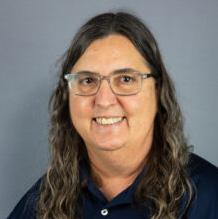
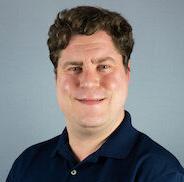
If you are thinking of becoming a leader and you are a part of the LGBTQIA2S+ community, we are behind you and support you! There are so many resources that you can reach to such as the NAD LGBT Section, Rainbow Alliance of the Deaf, Deaf Queers Resources Center, and more.
The NAD will always stand with the LGBTQIA2S+ communities. Let us unite for a better world for all people.
18
FEATURE DEAF LGBTQIA2S+ LEADERS IN OUR COMMUNITY
Jacob Leffler (he/him) serves as the Region I Board member for the 2020-2024 term.
Lisa Rose (she/hers) serves as the Region III Board member for the 2020-2024 term.
History Behind Rainbow Alliance of the Deaf
BY RAINBOW ALLIANCE OF THE DEAF
The National Rainbow Society of the Deaf (NRSD) was established in Ft. Lauderdale, Florida by eight white gay males in 1977. After almost 50 years, only two of these founders remain. Not only has the leadership of NRSD changed over time, but in 1982, the name of the organization changed, as well. NRSD became RAD – Rainbow Alliance of the Deaf.
Since taking on a new name, RAD also took on new responsibilities in the community at large. However, being tasked with hosting the biennial conference served to shine a light on some of RAD’s less flattering issues: RAD neglected their own Lesbians, Bisexual, Transgender, Intersex, Queer, Asexual, 2-Spirit, and + communities.
RAD took steps to remedy their mistakes. In 2019, during the Austin conference, RAD elected their
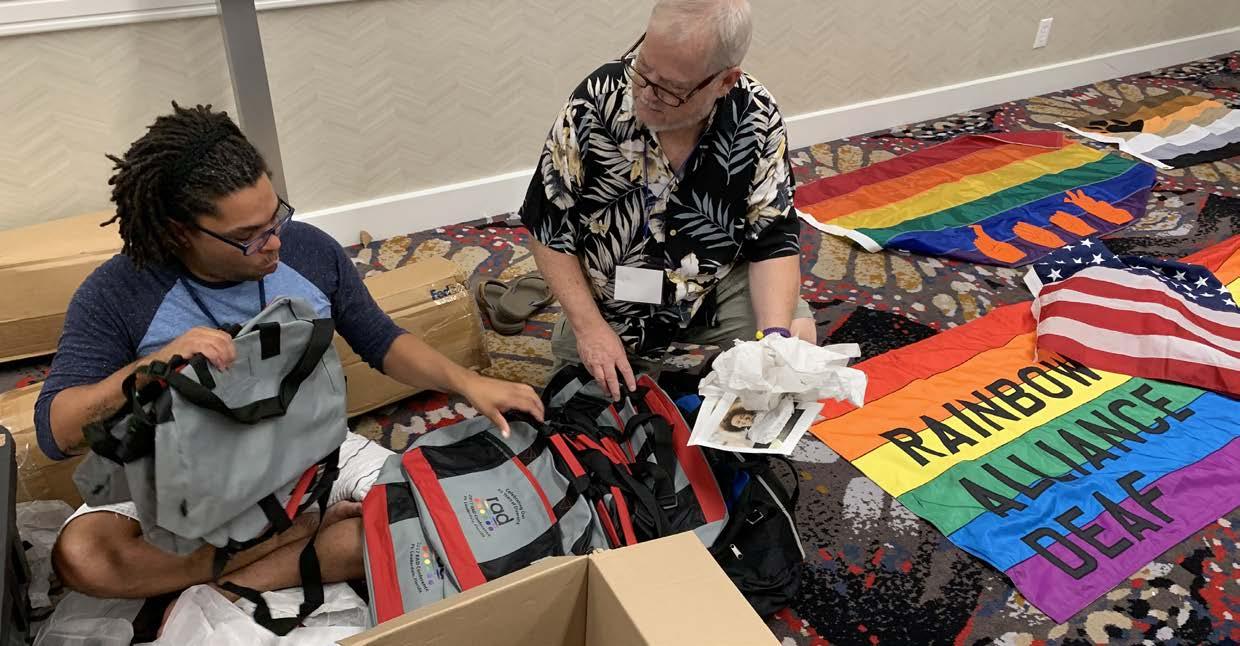
first-ever Black Queer to hold office as Vice President – Roy Jones. Simultaneously, RAD board appointed their first-ever Black Queer Director of Public Relations – Tar Burt. And then, only one month later, there was a scandal.
Former President Paul Kiel submitted his resignation as president – after spurring racist remarks.
Abandoning his post, Paul Kiel left RAD in unprecedented times. Roy Jones, Vice President, took over as President. Within the year, the RAD Board appointed Deidra Pelletier, another diverse board member, to be the first-ever Black female Vice President. Seeing RAD on the move and improving under Roy Jones’ leadership, a majority of the veteran white gay male board members resigned from their posts. Following their resignation, the RAD Board appointed Tar Burt as the first-ever Black Queer
19 NADmag | Fall 2022
FEATURE
RAD Conference committee preps the inserts at the 2019 RAD Conference.
Secretary. The RAD Board also voted to expand the Board to allow an opportunity for communities to have a voice – by creating new seats to accommodate more diversity representatives.
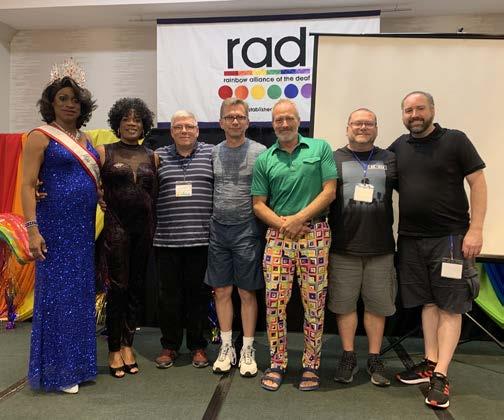
After such tremendous work and dedication, RAD found itself to have obtained a diverse majority of Black Indigenous People of Color (BIPOC) officers. It goes without saying: after the Jones and Pelletier administration, RAD has changed dramatically, entering to the modern era and positioning itself to focus on and advocate for its communities. RAD is finally in compliance with their mission to fight for and protect the Deaf LGBTIQA2S+ communities.
RAD has traveled a long road to arrive where it is now. After unpacking issues and healing past wounds – wounds RAD itself caused and consequently harmed its own communities with –RAD has finally arrived.
However, the journey is not over. There is still more work to do. RAD is planning a conference
HISTORY BEHIND RAINBOW ALLIANCE FOR THE DEAF




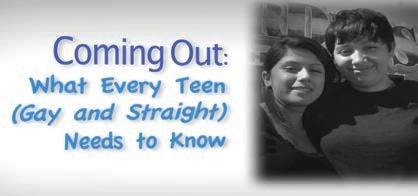

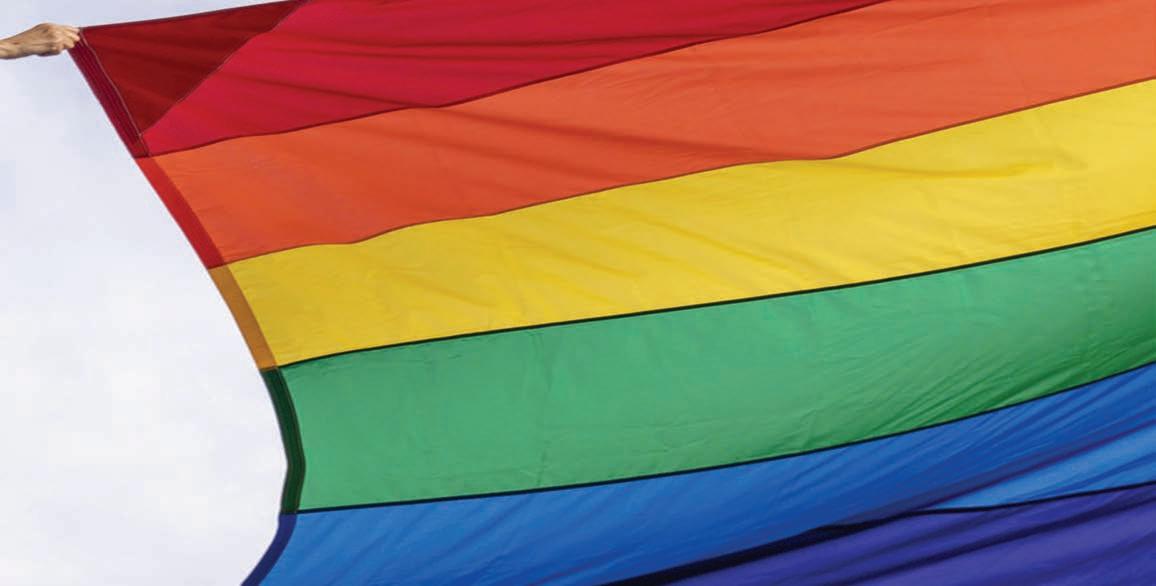
in 2023 in Little Rock, Arkansas! Check out RAD’s website at deafrad.org and follow them on Facebook @DeafRAD and Instagram @rainbowallianceofthedeaf.


FEATURE
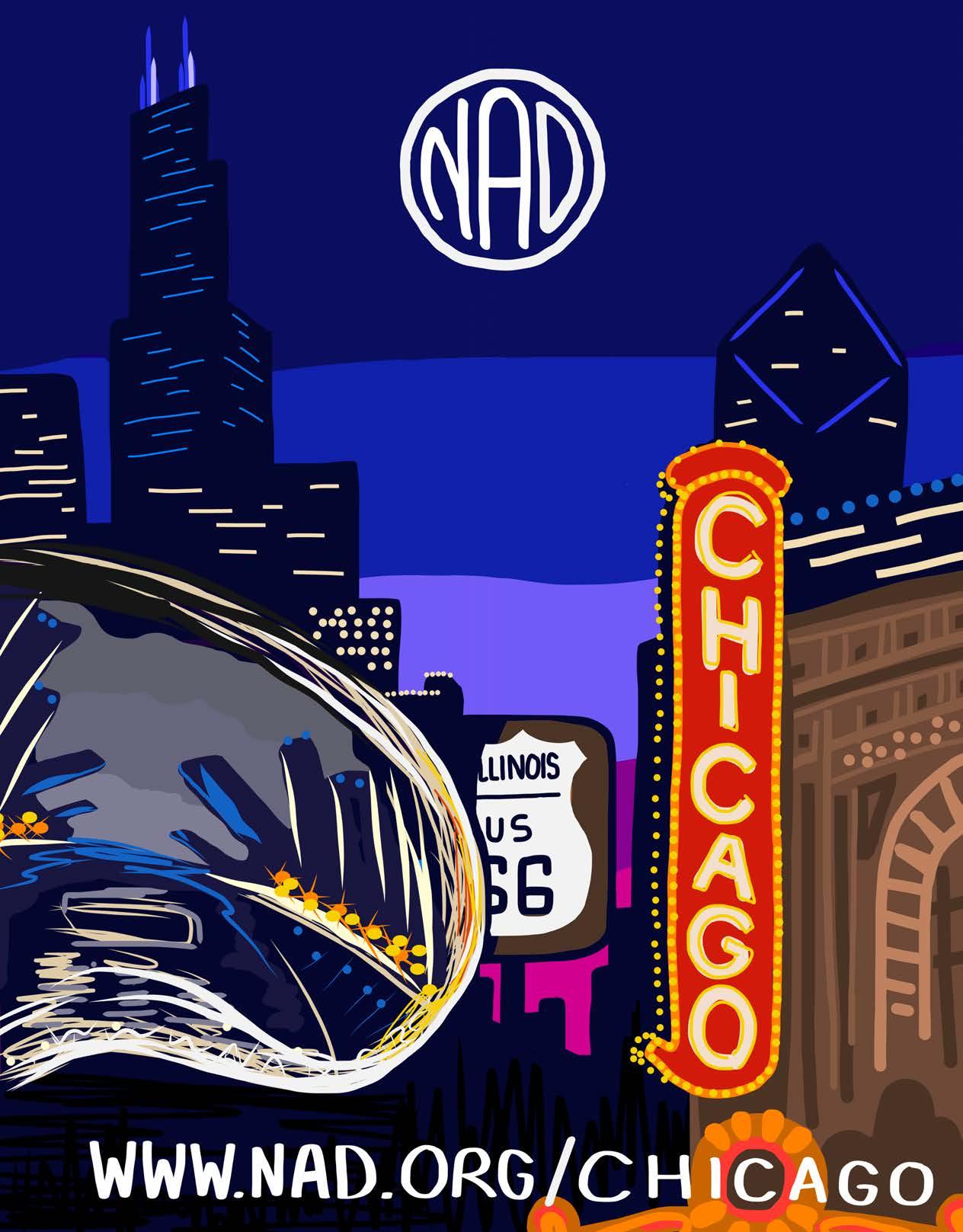

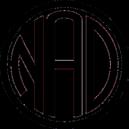
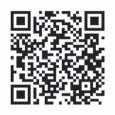





































































22 National leadership training conference September 21-23, 2023 | Albuquerque, New Mexico Deaf and hard-of-hearing students bring a variety of life experiences to RIT, but all have one thing in common — RIT is the right fit for them. NTIDadmissions@rit.edu rit.edu/ntid/fit 585-475-6700 (voice) 585-743-1300 (videophone) 866-644-6843 (toll free U.S. & Canada) Find Your Fit The Right Fit
Why Are Queer Interpreters Important?
Editor’s note: for the first time in history, the author decided to do this article in ASL first then translate it to English which means we have an ASL version available for readers to enjoy if preferred.
BY TOPHER ÁVILA (he, él)
First, this article is dedicated to Drago Rentería, one of my chosen familia, one of my role models and the Executive Director of the Deaf Queer Resource Center (DQRC), a national nonprofit organization. DQRC works to support, inform, empower, and bring more visibility to and awareness about marginalized Deaf LGBTQ communities.
Now, why are Queer interpreters important? How important is it for sign language agencies and translation companies to consider queer representation? These questions are important to discuss in our community. Answering that in this article would be best with community participation so I’ve asked some folks to share their perspectives.
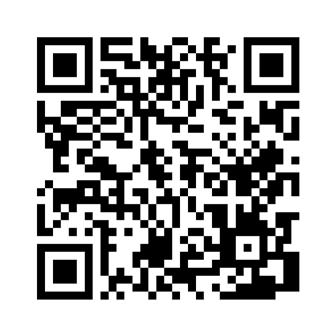
Ny’kel Best (she/her): “Because Queer people and interpreters can feel connected, based on who is a part of and identifies as the LGBTQ community. It will bring a sense of connection, bonding, and strength. For Queer interpreters, it’s easy to connect.”
melissa kelley colibrí (they/them): “They’re a part of our Queer community too, and it’s easy to connect.”
AV Vilavong (she/her): “Queer interpreters are important because of visibility, diversity, and the feelings of connection and empathy.”
Roberto Cabrera (he/él): “I love them because the information conveyed to me is valuable and significant. It has an impact for me as an individual. For example, marriage equality, health, insurance, HIV information, and safe sex practices – all of these important topics are impactful to me as an individual. Knowing more about them would benefit me and that is where the value is within interpreters who are Queer or a part of the LGBTQIA community.”
Idy Fass (they/them): “Mirroring. You know, to see that the interpreter and I are the same. Like, while they interpret, I would be thinking about my concerns as to how we could communicate, how to share my pronouns, how to disclose my identity, how to tell them not to do this or that, and to discuss their approaches. If the interpreter mirrors me, my concerns get reduced and I could focus better. Having no concerns with interpretations allows me to have smoother communications. Mirroring is important.”
Not too long ago, Rodney LeBon posted a custom “Lil Miss” meme where it read, “This assignment validates my existence and I’m really happy I get to interpret this’ Interpreter.” Basically, the meme was to share joy about how the interpreter gets a specific assignment that validates their existence, which made them really glad to interpret this assignment.
23 NADmag | Fall 2022
FEATURE
This meme brought me back to 2016, when I started working as a Deaf Interpreter (DI). At the time, I was working for Deaf Action Center (DAC), a local non-profit organization in Dallas and Fort Worth. I first worked with them in 2015 and as an interpreter coordinator. I eventually dived deeper into the field and became a professional interpreter. Anyway, in 2016, I remember my very first assignment. It was at Pride and it was right after I passed my first BEI certification exam. While I was out to very few, I was still very much in the closet to pretty much everyone else, especially my family. I was nervous to start interpreting, let alone take an assignment at Pride!
I decided to accept the assignment. I worked with a great hearing interpreter (HI) colleague and we worked well together. Following the assignment, I remember that there was a Deaf person, who was also Black/Indigenous/Person of Color (BIPOC) and they came to me asking for my name. We introduced ourselves to each other, and they asked me if I was hearing or Deaf. After I told them I was Deaf, I also added that I was Queer, too. I remember their facial
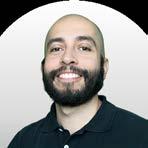
Call to action
WHY ARE QUEER INTERPRETERS IMPORTANT?
expression: a pleasant surprise. It seems like they were happy to see not only a fellow Deaf person on the stage but specifically a fellow BIPOC Deaf Queer person on stage. That assignment became one of my favorites of all time, easily. Both that consumer’s existence and my existence were validated in being BIPOC, Deaf, and Queer. That’s why Rodney’s meme resonated with me.
Queer interpreters are important because their existence is validation.
Queer interpreters are important because their presence is resistance of white supremacy, cisnormativity, and heterocentrism.
Queer interpreters are important because they are.
Interpreting agencies and companies, I ask you to consider not only Queerness but especially Blackness, Brownness, Disability, and so on. The Deaf communities are incredibly intersectional, and it is imperative that we have interpreters who understand our identities and lived experiences on an innate level. Otherwise, it can be a matter of life and death, whether it be in school, workplace, healthcare, courtrooms, jails or prisons.
That is why Queer interpreters are important.
Please consider supporting and making a donation to the Deaf Queer Resource Center. ¡Muchas gracias!
24
FEATURE
Topher Ávila (he/él) is a life enthusiast / filmmaker / advocate / Deaf interpreter (DI) living on Earth.
Pronouns: Why Is It Important to Normalize Pronouns?
BY BEE GEHMAN (they, she) AND melissa kelley colibrí (they, them), JOOUX CENTER
You may have noticed that people are sharing their pronouns in introductions, on name tags, and at the beginning of meetings. This gives everyone in the room the opportunity to self-identify instead of others assuming someone’s identity or which pronouns they use. Including pronouns is a first step toward respecting people’s identity and creating a more welcoming space for people of all genders to be able to coexist.
Every human being on this earth has different experiences. Think about all the individuals you’ve met with diverse life experiences, navigating through their lives with barriers and privileges. Navigating with one same desire: to love and be loved. That is the essence of our human experience - to belong and feel seen as a whole person. To be in a space where they feel comfortable in their own skin and being loved. It is our desire for you, readers, to understand the pain of having part of yourself dismissed by others. And that radiating joy that inspires from within when you are seen. Pronouns are an avenue to show people that they’re seen and accepted for who they are.
Pronouns are a powerful tool to create a space for transgender, non-binary, and gender non-conformed communities to feel comfortable in the identity they were born with. As we, melissa and Bee, invite you into this sacred space to explore and understand the importance of normalizing pronoun usage, it is necessary and important to acknowledge that we are sharing from our own personal experiences and expertise. There are multiple truths with pronouns.
There are numerous stories and experiences waiting to be shared. We all share a responsibility to create a space for the rest of untold stories to be told.
Pronouns are the words you want others to use for you in place of your name. Some examples include “she/her” or “he/him” or gender-neutral pronouns, such as “ze/hir,” or “they/them”. Some people use specific pronouns, any pronouns, or none at all. Here is an example of using “they/them” in a sentence: Adrian is covering for me today and they are a phenomenal teacher.
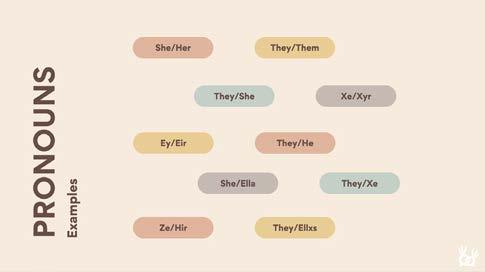
A cool tidbit to share here: using singular “they” pronouns has been used in the English language for centuries. If you are still struggling with using the word ‘they’ to refer to a singular being, remember it takes practice!
When someone shares their pronouns with us, they are communicating ways we can honor their existence with respect. When we respect them by using their pronouns, we are creating a space for them to show up as their full selves. Every human has a right to exist as their authentic self.
25 NADmag | Fall 2022 FEATURE
In order for each one of us to exist as our full selves, we need the following items: emotional safety, boundaries, shared emotional connection, a sense of belonging, and identification. For centuries, individuals in various oppressed groups (Black, Brown, Indigenous, People of Color, queer and trans, disabled, and more) experience limited access to privileges for feeling safe.
Each being has a sexual identity. Sexual identity is an individual’s sense of self as a sexual being. This identity includes gender identity, gender expression, sexual orientation and sexual self-concept. Pronouns are a form of gender expression. By using pronouns, people are being gifted with the freedom to define themselves and create boundaries with how they would like to be identified. For some people, it is a revolutionary act of self-love. It’s also an act of challenging the gender norms in our society. Gender norms are a way for people to put themselves and others into boxes without allowing the creative expression of being their authentic selves.
Pronouns can sometimes be a signifier for someone’s gender identity, but not always. We do not want to assume people’s gender identity based on expression (typically shown through clothing, hairstyle, mannerisms, etc.). By providing an opportunity
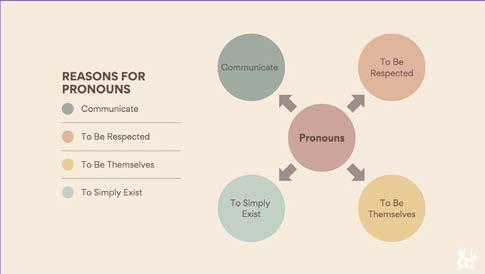
for people to share their pronouns, you are not assuming that their gender identity is based on their appearance. That is one important way we can practice inclusivity.
It’s okay if you prefer not to share your pronouns. Providing space and opportunity for people to share their pronouns does not mean that everyone feels comfortable or needs to share their pronouns. Some people may choose not to share their pronouns for a variety of reasons: they are questioning or using different pronouns, they don’t use any pronouns, they don’t feel comfortable sharing them at that moment or in that space, or they fear bullying or harassment after sharing.
If you happen to notice that someone has left pronouns off the nametag or chosen not to share their pronouns, please refrain from using pronouns for that person and refer to the person by what is on the nametag.
Bee’s co-presenter at the NAD Conference 2022, Diego Guerra, has shared a beautiful example of honoring each one’s existence. Diego explained using one’s correct pronouns without any doubt or question asked is like using someone’s correct sign name. In our Deaf, DeafBlind, DeafDisabled, Late-Deafened, and Hard of Hearing communities, we clearly know the importance of using people’s correct sign names. It is one simple act to honor their existence. When someone changes their sign name, we often do not argue with them for having a new sign name. Diego made a point of using correct pronouns. If it is simple enough for us to use someone’s new sign name without any question, it should be the same for pronouns.
26
FEATURE
By using pronouns, people are being gifted with the freedom to define themselves and create boundaries with how they would like to be identified.
PRONOUNS: WHY IS IT IMPORTANT TO NORMALIZE PRONOUNS?

The word “misgendering” usually comes up in conversations surrounding pronouns. Misgendering refers to the experience of being labeled by others as a gender other than one that a person identifies with. Because many (not all) associate their pronouns with their gender identity, using the wrong pronouns intentionally or unintentionally is a form of misgendering. If you accidentally use the wrong pronouns when identifying someone, please apologize or say “thank you”, and immediately use the right pronouns. For example, you say, “This is Ezra, she is one of my students.” Then you are being corrected because Ezra uses they/them/theirs pronouns, you can respond with, “Sorry, they are one of my students.” Or even better, you can say, “Thank you, they are one of my students.”
have reasons for their chosen pronouns and for some people, pronouns do not hold a significant role in their lives. All of that is valid.
We do not have to understand in order to create an affirming and safe space. It is not relevant to how we co-exist. One thing is for sure: we do have a collective responsibility to treat each other with respect and dignity. We invite you to join us in this beautiful and radical act of creating spaces where we can honor each being’s existence, including using their correct pronouns.
Everyone makes mistakes, please take accountability for your mistake and continue using the correct pronoun when prompted or reminded. The important thing to be mindful of is to not unload your guilty feelings on transgender, nonbinary, and gender nonconforming people or expect forgiveness. They might have a strong reaction to the misuse of their pronouns and need space to ground themselves.
It is impossible for us to understand a simple thing like, “why do we have to understand people’s reasons for their pronouns?” Well, for example, some people have special meanings behind their sign names and some people don’t. It’s time for us to look at pronouns in such a similar way. Some individuals
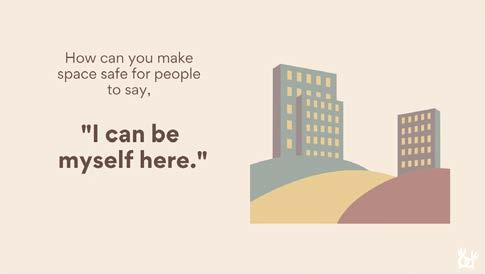
Bee Gehman (they/she) M.Ed., CSE, Founder and owner of Jooux (Deaf Sexual Wellness Center) is an AASECT certified sexuality educator, with more than a decade of experience in providing caring, contentious, thoughtful sexual health and education services and professional training for educators and interpreters.
melissa kelley colibrí (they/them) is the operations manager and access coordinator for Jooux Center.
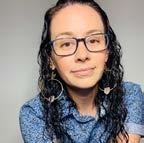
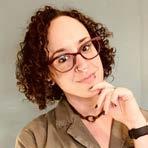
27 NADmag | Fall 2022
TAKE-AWAYS
Intersecting LGBTQIA2S+ Identities
BY STEPHANIE HAKULIN (she, hers) AND LIZZIE BLOOM (she, hers)
As part of the commitment to address one of the 2020-2022 priority, “Dismantling Racism in the Deaf Community,” the NAD hosts a monthly webinar series, ‘Real Talk, Good Action.’ During PRIDE in June this year, the NAD held a webinar with five deaf queer participants, “Intersecting LGBTQIA2S+ Identities and Anti-Racism Work” – moderated by Tommy Minch (NAD LGBT Section Chair) and panelists Jerald J. Creer, Josie Krueger, Miki Smith, and Ivy Vélez.
Tommy moderated the panel using a slide that provided a word prompt for the panelists to engage in a discussion and to share their experiences with that word. This article provides brief snippets of their discussion, some of which may be taken out of context so we encourage you to watch the full webinar recording which can be found by scanning the QR code on the right.

IDENTITY
Miki. You know, coming up in a deaf school as a deaf person, obviously, like most of us – I went to a school that was mostly white. Which was vastly different from home. I grew up loving and living Black culture. That’s who I am. My family is very Black. And then to go back to a white deaf school where my Black culture was typically erased… where the focus was more on being deaf, Deaf Pride, all way deaf.... where race was not something that was necessarily acknowledged. And so that was a huge issue for me.
Jerald. When I finally got into high school, I went to an all Black private school but I was the only deaf or hard of hearing person there. I didn’t really find my gay identity until high school, I always felt it growing up but it wasn’t until high school that I really connected with that identity. That’s when it really hit me.

Ivy. I come from a multi-generational Deaf family. And while my family was very open and accepting of gay folks at the Deaf club – they never really acknowledged the Deaf folks were gay, just that they were Deaf. My family always said I wasn’t like the other lesbians even though they accepted me as as a


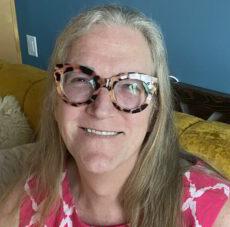
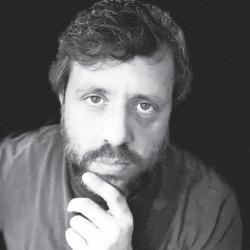
28
FEATURE
Tommy (he/him) is a white gay man. Jerald (he/him) is a black deaf gay man. Josie (she/hers) is a transwoman. Miki (she/they) is a black deaf queer woman.
Ivy (she/hers) is a latinx lesbian.
lesbian. I didn’t really understand what that meant. Now that I look back, I realize the insecurities I had as a lesbian. For example, growing up in the 1970s, I was crushing on Kristy McNichol big time but I felt that was wrong. Right then and there I knew I liked girls. This was going to be a problem because the Deaf community didn’t accept us. I knew it would be the end of me if my family found out I was a lesbian. So I hid who I really was. Hiding who I was caused a lot of emotional and mental trauma, internal turmoil, where I’m constantly telling myself, “I’m Deaf, I’m Deaf, I’m Deaf.”
Josie. I went to a deaf program at a hearing school. I remember being about four or five years old and telling my classmates that I was a girl and that I like boys. Eventually, I went to a deaf school and the same thing happened there. People just kind of wrote me off that I was gay. I’d tell them, “No, I’m a girl so I’m straight if I like boys.” At the time, I was forced to accept the gay identity. Keep in mind, this was back in the 1980s when we didn’t have internet, counseling, or therapy. I remember going to the library to learn more but books were either censored or hidden so my access was quite limited. Hearing people have access to spoken dialogue and developed their identities that way but my access to information was much more limited as a Deaf person and this was something that was not discussed… I finally transitioned when I was 46.
OPPRESSION
Jerald. I consider myself as a survivor of Deaf Culture and Deaf Education. And the reason I say that is because I grew up in a hearing family and I went to hearing schools. Most of the time, I was either the only deaf student or I was one of two or three other students in the entire school. So that was a very oppressive experience as a deaf person. Even though it wasn’t intentional and people meant well, there’s only so much that hearing people can learn. I never got an appropriate education related to ASL.
TAKE-AWAYS | INTERSECTING LGBTQIA2S+ IDENTITIES
I never had an education that exposed me to Deaf Culture. I was deprived of my true language, ASL.
Miki. I’ve often experienced racism clearly because that the first thing you see about me when you take a look at me, I’m Black. I’ve faced oppression due to the fact I am a woman. I’ve faced oppression because I’m queer. Sometimes people look at me and can’t tell I’m queer and that’s something people can often overlook or downplay even.
RACE
Jerald. Race does play a big role in my life in a lot of ways. Our Black Community has to work hard, has to be resilient, and we have to stick together. We have to be tough because we’re constantly having to advocate and convince others to see us as we are.
Ivy. My mom is a role model in so many ways, and she always said to show up. My mom never gave up. Whether it was a workshop or deaf club, we went – because she said deaf Latinx can do this. Because she’s right, we need information and we don’t get it out there from our deaf white peers… I can see that race plays such a part in developing an identity… The Deaf community is not just a bunch of white deaf folks, it really is intersectional.
Miki. When I get home from school, my mom would say, “It’s important that when you go back to that school, you follow what those White folks say. They’re going to help you succeed in life. They’re going to help you get to where you need to go. Keep in mind that when you come back home, be yourself. You’re a Black girl. You are soulful and we do what we do here in this house. But when you go back to that school, you do what they tell you to do. You assimilate with them. White folks will tell you what to do. They’re going to help you.” And I would think to myself, I have to not just code-switch but I have to switch out my identity. I have to suppress my identity when I go back to school. Then when I go back home, this is where I get to be who I am
29 NADmag | Fall 2022
as a Black Deaf person using Black ASL. So that definitely made an impact on me, knowing that in Deaf Community, that was required of me.
INTERSECTIONALITY
Ivy. Deaf, hard of hearing, DeafBlind, all folks in the Deaf Community don’t talk about race. We’ve gone through years of oppression and this toxic means of information and how we can navigate these conversations can get very heated. When we talk about intersectionality in the Deaf community and actually navigate through it transparently, that’s when we make change. Oftentimes, we talk about having an open dialogue, but when people show up and say, “I am Deaf first,” it means they’re not honoring something.
Jerald. Intersectionality really allows us to take ownership, partnership, and pride within ourselves. It’s more about allowing ourselves to identify who we are than it is for other people to tell us who we are. It’s a way for us to share who we are in a more nuanced manner. It gives people the opportunity to respect experiences that we have.
DATING LIFE
Ivy. You know that awkward feeling when you’re newly dating someone in high school and then you break up, and it’s a mess. And it’s dramatic. And it ends up feeling like a TV show. We have to remember that dating happens for a reason. And today, dating is different you know, I wish I had that because my quality of life would have been so different as a young lesbian years ago. We didn’t have permission to do that. We didn’t have permission to live our truth.
Miki. Dating can be tough in the Deaf world. It’s small and we’re very well aware of it. Everyone knows everyone else which makes it tough.
Jerald. When we’re talking about how you’re dating, your circle shrinks over time. So for example, if you’re a White man, it’s a big circle. If you want to
narrow it down to dating someone who is Latinx or Asian, your dating pool gets smaller and smaller. For me, I feel like I almost have no options within the Black community because there’s not many Black gay lesbian folks within the community. When I came out, I couldn’t learn from the Black Community, I had to learn from my White peers. Eventually, I discovered the Men of Color Health Awareness (MOCHA).
Josie. Before social media, you were either straight or gay. You didn’t know what else existed or what trans looked like. There were no role models available to us. Now we have social media and more exposure on TV. This is great. It’s a wonderful thing for us to be able to experience more. People speaking out loudly and proudly about it.
DON’T SAY GAY
Jerald. I work with deaf youth. I want to make sure they have authentic transparent conversations with other deaf community members within Massachusetts (with Deafinitely Inc. where I work). The ‘don’t say gay’ law really impacted me, I was devastated when I learned about it. I’m fearful for the youth in Massachusetts. I can’t imagine how that information will impact other youth in other states. Deaf youth are currently in the process of coming out, tackling intersectionality – we’re starting to see children identify who they are at a very early age, so to have that taken away from them at such an important time period is really devastating.
Miki. It hurts me to the core. In my experience growing up, I’d try to understand my identity and it wasn’t until my late 20s that I was able to just hold on to and embrace my queer identity. Now I look at the new generation and I’m amazed and floored. There are 12 and 13-year-olds saying, “Yeah, I’m trans.” It warms my heart. It makes me so elated to see young people knowing who they are and being determined to express who they are at such a young age… Now we are going back to, “No, let’s not talk about this.”
30 FEATURE
ADVICE & TIPS
Miki. Open up your mind. Open up your heart. But not just that, listen and ask questions.
Ivy. Not only that, yes, listen but also take feedback as a gift. And be a member. Be part of the conversation. Don’t just ask for information. Include us. Ask us to be part of your learning.
Josie. The bottom line is that we are people. We’re humans, just like you. We have our own dreams. We have our own needs. We have our own goals. Just like everybody else. We’re not any different just because we’re trans.
Jerald. Unpack all these things you learned that are preventing you from connecting with people as a human. Learn about us. Learn about LGBTQIA2S+ organizations. Learn about queer children and families. You probably have one or two LGBTQIA2S+ folks in your families who may be afraid to come out because of something you said before.
Tommy. Please think about our future and make sure that they are and feel safe.
TAKE-AWAYS | INTERSECTING LGBTQIA2S+ IDENTITIES
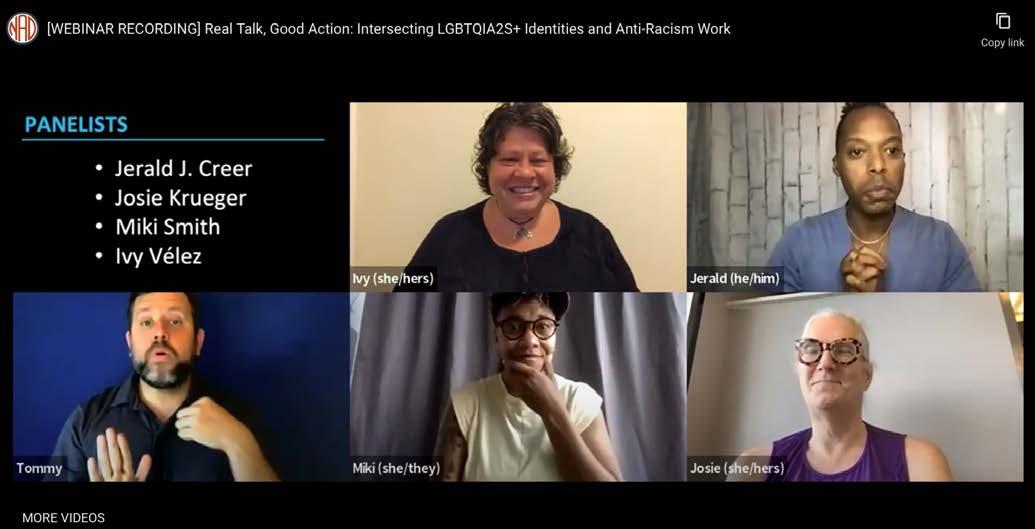

The NAD thanks the panelists for their time serving on this important panel. You can watch the full recording online to get to know the panelists and learn more about their contribution to this important topic. Other resources to consider include the Rainbow Alliance for the Deaf (deafrad.org ), Deaf Queer Resource Center ( DEAFQueer.org ), the NAD’s LGBT Section, and your local LGBT organizations.

31 NADmag | Fall 2022
Stephanie Hakulin (she/hers) is the Vice President of the NAD for 2022-2024.
Lizzie Bloom (she/hers) is the Director of Engagement at the NAD.
Five deaf queer participants share their experiences during a NAD monthly webinar series in June.
Parallel needs in supporting trans deaf communities
BY OLIVER STABBE (he, him, they, them)
It is a joy and a privilege to be a member of the trans1 and deaf communities. Though remarkably different communities in terms of language, culture, and identity, I learned how to authentically express myself through comradery of others like myself in these communities alike. That empathy and support isn’t the only thing that these communities share. Among the many commonalities, both trans and deaf communities are beautiful and revered for their advocacy, resiliency, and passion for justice.
There are other odd parallels I could share, like these communities’ battles to have language for oneself, the intensive process of getting a new name, or fighting against insurance companies to get ‘elective’ but essential services that some people need. The thing that’s most important to share, however, is similarities in needs from our supporters. So, what do those aiming to advocate trans deaf communities need to know?
to well-intended people curious about what it means to live as a Deaf person. It seems intuitive within the community; no one deaf person is like anyone else. It’s a lesson that humbles us and teaches us to value our differences. But, for people outside of our community, it can come as a surprise. Inside our community, we know that we are more than their assumptions and more than a one-dimensional figure.
This is not an isolated experience, but one common to so many minority communities, including the transgender community. Individual decisions and needs regarding transitioning are personal, whether it be a decision to use hormones, come out, or legally change one’s name, there’s no one right decision and there’s certainly no one way to ‘be.’
The heart of being transgender and deaf is about the relationship we have with ourselves and who we know ourselves to be, not about what we do about that.
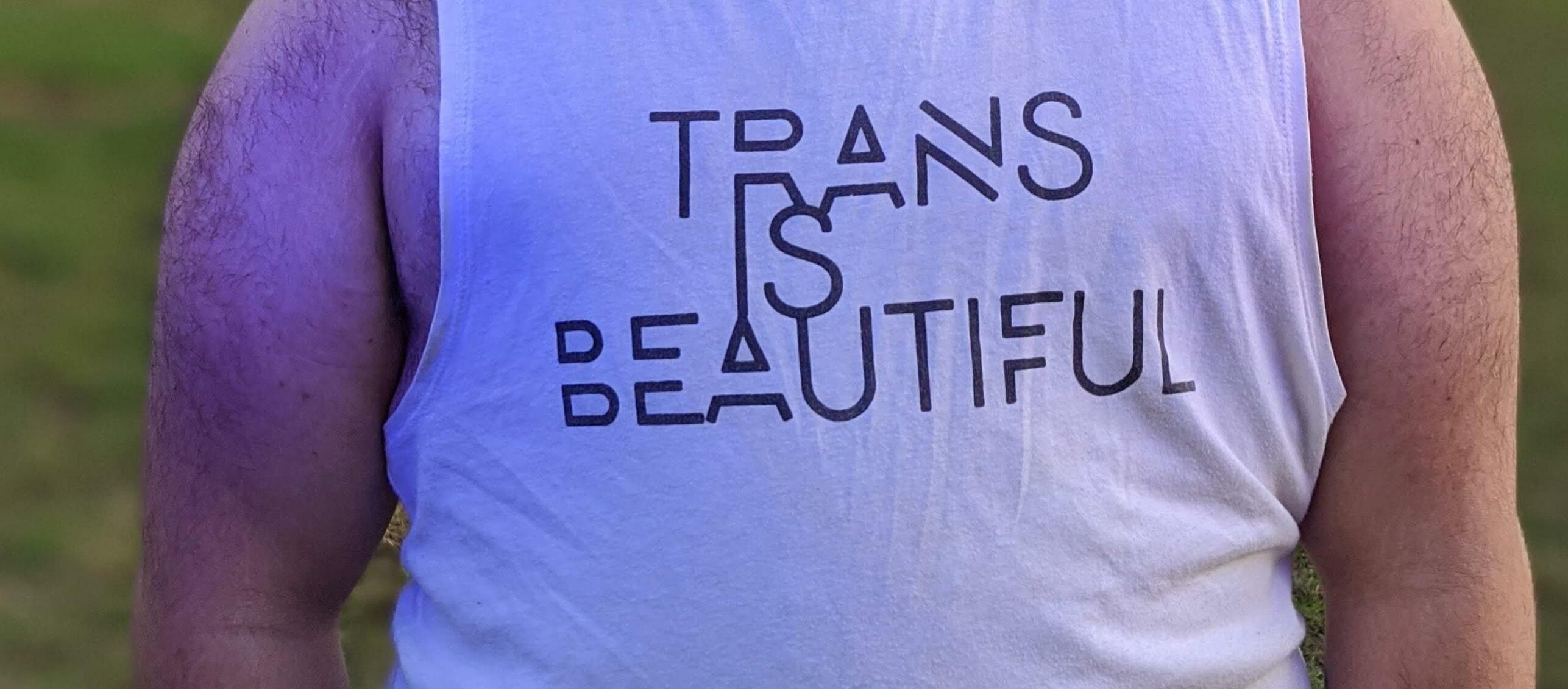
1. There is no singular experience. We know there’s no one way to be deaf. There’s no one way to be trans either.
Language, technology, tools, hearing loss, social lives - it all varies person to person. Time and time again, we explain ourselves and individual decisions
References used in this article:
2. Allyship is a verb, not a noun. Allying is what you do, not who you are. You can’t simply ‘be’ an ally. It must be practiced.
No one is asking you to become a seasoned activist, but it’s important to accurately discuss communities with up-to-date language and in a way reflective of our actual lived experiences. It’s easy to get
1) Transgender (also expressed as trans) is an adjective to describe someone whose gender assigned at birth is different than their current gender identity.
32 FEATURE
misinformation because of the stigma and violence we face. It takes active effort to educate yourself from trustworthy sources. The most reliable way to do that? Go to the source. Take classes led by, follow the work of, and subscribe to social media sources curated by community members.
Examples of allyship:
• Use someone’s chosen name, name sign, and pronouns without question or judgment.
• When you mess up, apologize and move forward.
• Don’t rely on your trans friends to be Google for you – actively seek out resources on your own.
• Use gender inclusive language in both ASL and English.
• Self-reflect on your own identities. Allyship should not be easy! When we think of allyship, we tend to imagine showing up at protests and rallies. Allyship doesn’t end there. Most allyship happens unseen by others through self-reflection. Just because you have a good attitude about and are open to learning about our communities, it does not mean you are standing with us. Allyship takes more than that. It’s uncomfortable and it requires assessing your own values about gender and disability that do not stand up to scrutiny. For example, why do we believe that length of hair tells you someone’s gender? When we think critically about ways in which these biases intersect with other assumptions rooted in ableism, audism, vidism, transphobia, sexism, racism, and colorism, we can identify beliefs that undermine progress and harm trans deaf people.
PARALLEL NEEDS IN SUPPORTING TRANS DEAF COMMUNITIES
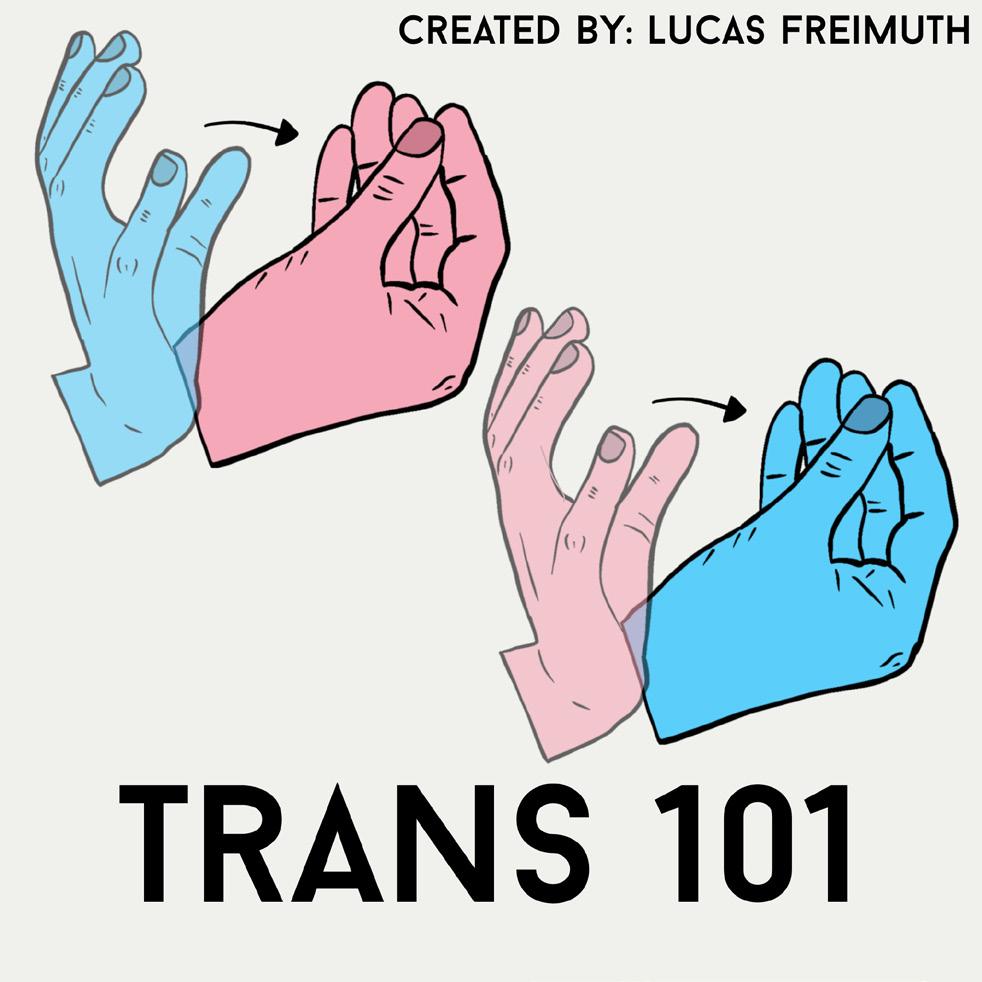
3. Oppression is systemic.
It’s unfortunately common for individual trans deaf people to experience oppression in the form of name calling, discrimination, gatekeeping, and more, regardless of environment. Real harm happens to individuals but looking only at one-off incidents can’t fully explain oppression. Instead, we have to take a step back and look at the way that systemic biases exist. Systems are a collection of parts that are organized for a common purpose. Looking at all these parts function together makes it look like a well-oiled machine, but up close we can see that each part was created and affected by social biases. For example, the legal system is notoriously hostile and difficult for trans people to navigate, even though
33 NADmag | Fall 2022
everyone
“Among the many commonalities, both trans and deaf communities are beautiful and revered for their advocacy, resiliency, and passion for justice.”
is supposed to be able to rely on and trust it equally. If you look at any individual part of the legal system, such as basic documents that require checking of “male” or “female,” there are countless barriers trans and deaf people face to entry and for fair treatment within the system.

Examples of how to improve organizational support of trans deaf people :
• A pproximately 10% of the United States are LGBTQ2 . Collect demographic data on job or volunteer application to ensure your workplace is representative of the general population.
• Create non-discrimination policies that explicitly name identities and communities who are disproportionately harmed in your workplace.
• Hold ongoing trans competency training for staff and volunteers.
Final thoughts
Undertaking the fight for equality for our trans deaf siblings benefits everyone. We need to collaborate across movements, and center people who are more vulnerable to systemic harm. Deaf and trans communities must work in partnership as we’re combatting the same assumptions about our identities and bodies that limit our abilities to live full lives. In taking a step back and taking these truths to heart, we can get one step closer to genuine progress.
PARALLEL NEEDS IN SUPPORTING TRANS DEAF COMMUNITIES
Oliver Stabbe (he, him, they, them) is a public health researcher and practitioner ameliorating the impacts of social determinants of health on vulnerable populations through legislative action, data analytics, transformational education, and program interventions. For more information about Oliver, check out their website at okstabbe.com

34
FEATURE
Photo credit: Mary V. Benoit
References used in this article: 2) https://news.gallup.com/poll/389792/lgbt-identification-ticks-up.aspx
Oliver stands in-front of a trans flag, taken by Oliver.
Healthcare and the Deaf LGBTQ Community
CENTER FOR DEAF HEALTH EQUITY (CDHE), GALLAUDET UNIVERSITY
The goal of this article is to explain the different healthcare experiences that deaf lesbian, gay, bisexual, transgender, and queer (LGBTQ) adults experience in the USA.
Our research team received several federal grants between 2015 and 2021 to conduct a large study with deaf people from diverse backgrounds, including LGBTQ adults. For the sexual and gender minority grant from the National Institutes of Health (NIH) that was awarded to the Center for Deaf Health Equity, we interviewed over 500 deaf LGBTQ adults and asked about their health history and access to healthcare. For example, for adult participants who self-identified as deaf gay, bisexual, or queer men, we asked how much they knew about pre-exposure prophylaxis (PrEP) and if they thought PrEP was successful in preventing HIV. We also asked all adults who self-identified as LGBTQ if they felt comfortable telling their healthcare providers about their sexual orientation or gender identity.
Deaf LGBTQ People May be at Risk for Some Medical Conditions
Deaf LGBTQ people experience higher risk than deaf non-LGBTQ people for some medical conditions like lung disease, arthritis, depression, and anxiety.1
Deaf nonbinary transgender adults have higher rates of depression or anxiety than deaf binary transgender adults.4
Providing more ASL-accessible resources and reducing stigma may close the gap of health disparities experienced by LGBTQ deaf adults, especially those who are nonbinary.4
Deaf LGBTQ Adults May Not Share their Identity With Healthcare Providers
Bisexual or queer deaf adults are less likely to share their identities with healthcare providers than gay
or lesbian deaf adults, and cisgender women are less likely to disclose their LGBTQ identities to health care providers than cisgender men.3
However, LGBTQ individuals who felt accepted by their loved ones are more likely to share their identity with their healthcare provider compared to others who do not feel accepted.3
LGBTQ patients may hesitate to disclose their sexual or gender identity to healthcare providers because of how our society easily accepts and normalizes straight people and their relationships.3 Changing that may improve healthcare experiences for deaf LGBTQ people.
Having an Online Community is Beneficial Gay, bisexual, and queer men who met LGBTQ friends online were more likely to be aware of PrEP (anti-HIV medication). Those who discussed LGBT-
35 NADmag | Fall 2022
FEATURE
related issues online were more likely to believe that PrEP helps prevent HIV compared to those who did not participate in an online LGBTQ community. 2
Online LGBTQ communities are a valuable resource for sharing information, especially about PrEP. 2
CALL TO ACTION
There is a need for comprehensive health care services for deaf LGBTQ adults that include culturally and linguistically competent providers.1
About
The Center for Deaf Health Equity at Gallaudet University
The Center for Deaf Health Equity’s mission is to conduct research that links accessibility to health outcomes among deaf and hard of hearing individuals. The content is sorely the responsibility of the authors and does not necessarily represent the official views of the National Institute of Health (NIH). View their website at gallaudet.edu/DeafHealth and follow them on Facebook at facebook.com/ DeafHealthEquity.
References used in this article:
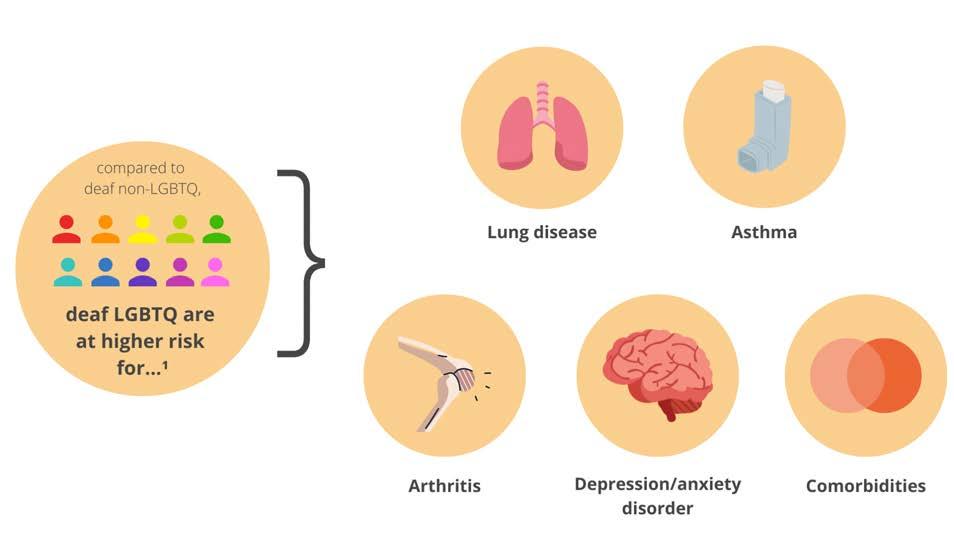
1) K ushalnagar, P., & Miller, C. A. (2019). Health Disparities Among Mid-to-Older Deaf LGBTQ Adults Compared with Mid-to-Older Deaf Non-LGBTQ Adults in the United States. Health equity, 3(1), 541–547. https://doi.org/10.1089/heq.2019.0009
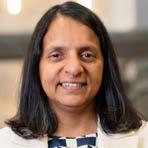
2) B iskupiak, A., Smith, S., & Kushalnagar, P. (2018). Pre-Exposure Prophylaxis Knowledge and Perceived Effectiveness to Prevent HIV Among Deaf Gay, Bisexual, and Queer Men. LGBT health, 5(8), 469–476. https://doi.org/10.1089/lgbt.2018.0102
3) M iller, C. A., Biskupiak, A., & Kushalnagar, P. (2019). Deaf LGBTQ Patients’ Disclosure of Sexual Orientation and Gender Identity to Health Care Providers. Psychology of sexual orientation and gender diversity, 62(2), 194–203. https://doi.org/10.1037/sgd0000319
4) S anfacon, K., Leffers, A., Miller, C., Stabbe, O., DeWindt, L., Wagner, K., & Kushalnagar, P. (2021). Cross-Sectional Analysis of Medical Conditions in the U.S. Deaf Transgender Community. Transgender health, 6(3), 132–138. https://doi.org/10.1089/trgh.2020.0028
36
Poorna Kushalnagar, Ph.D. (she/hers), CDHE Director; Chief Research Officer, Gallaudet University
FEATURE
HEALTHCARE AND THE DEAF LGBTQ COMMUNITY
As of September 2022
California School for the Deaf Riverside Gender Sexuality Alliance club
Illinois School for the Deaf LGBT Club

Lexington Gender and Sexuality Association
Marie Philip School Gender and Sexuality Alliances
Maryland School for the Deaf Gender Sexuality Alliance club
Rochester School for the Deaf GSA club for middle school students
Texas School for the Deaf PRIDE
If your school has one and isn't listed above, let us know -- we'll add it to the most current listing online!

37 NADmag | Fall 2022

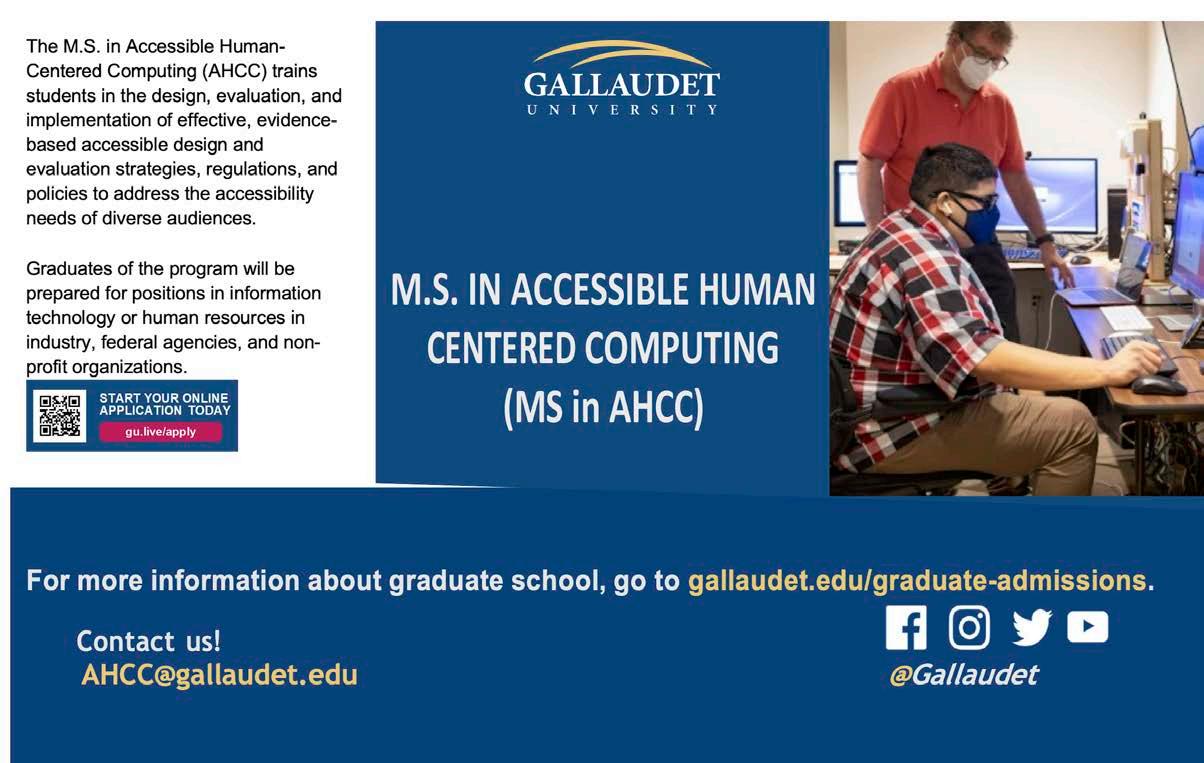
Deaf Humans of PRIDE
 BY ARIEL BAKER-GIBBS (she, hers)
MJ Bienvenu, 69 (she/hers)
BY ARIEL BAKER-GIBBS (she, hers)
MJ Bienvenu, 69 (she/hers)
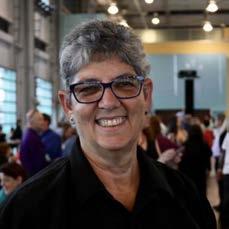
I grew up in Baton Rouge, Louisiana. I’m a Deaf lesbian. I was born in 1952. I’m from the 50s and 60s, when gays and lesbians were not accepted or embraced, so I grew up really just thinking of myself as Deaf, and that’s all. But now that I look back, I realize all my crushes were on woman teachers and not men. Because I read a lot of books, I learned that I had to find a man to have a crush on. I couldn’t find any but I definitely found women. I didn’t understand at that time because it was taboo and we couldn’t talk about it. It was at Gallaudet that I finally understood— that was where I had my first relationship. Then I chickened out and went back into the closet. I had a few relationships at Gallaudet, but I denied them, saying I was straight, straight, straight. It was about 1976 or 1977 that I met a new girlfriend and became more open about it, but it wasn’t until after 1990 that I never went back into the closet again. I was 38 then. My family and friends all knew, but to be professional at work, you had to look proper and straight. Then I decided, what’s wrong with a pantsuit? And it’s been like that ever since. It’s funny—there was five of us who were close, back in college, and now three of us are lesbians. I tended to feel more connected to people who grew up signing, with Deaf parents or who went to Deaf school. It wasn’t until later, when I started exploring my identity as a lesbian, that I realized I had also been connecting with other lesbians.
Growing up, there was some mention about homosexuality, but it was very negative. I remember there was a woman I didn’t know, but people said she was a bit funny in the head. I took that literally, but later I realized what people really meant. That was 1960, so maybe this woman was already in her 50s. It must’ve been so hard for her. Another thing I remember was at school—I’m the baby of three sisters, there’s Jo who’s also a lesbian, then Pauline, then me. The dorm keepers always said to please be more like Pauline, not like Jo. I always thought that was because Pauline was on the honor roll, but looking back, it’s obvious. They knew who Jo was. And they didn’t want me to be like her. They wanted me to be like the straight one. That was their message.
Melissa Elmira Yingst, 44 (she/hers) I was born and raised in Southern California. I identify myself as a Latina queer feminista, and obviously I am a proud Deaf woman, too. I do a little bit of everything, but my main job is as a marketer. I also have my show Melmira, which is more of a side gig. I also teach ASL on the side.
I lived a very heteronormative life for a long time. I was married to a man. So, this journey was surprising for me, and very scary. When did it start? Honestly, looking back, I always probably had it in me, but I just never had space to explore it or allowed myself to be curious. My family is very religious, too, so maybe I grew up with that thinking that it was wrong, that it was not something I should explore. It wasn’t until much later, when I joined Deaf Women United (DWU) that I went to a workshop where we were
39 NADmag | Fall 2022
FEATURE
discussing sexual identity. I sat there listening to everyone as they went around, and then I started to feel like, “Oh…” Their stories made me look at myself differently. It was probably that moment that I realized I could be queer. I could see how there were some thoughts and feelings that I had repressed. Of course, it wasn’t exactly easy for me to admit this. I struggled—because of my life at that time, my family, my marriage. That was a big turning point in my life, when I was like, “Uh… I’m queer?” And then the question was, “What do I do about it?” That was in 2015. At that point, I knew I was attracted to women, but I wasn’t sure how to go about it. I could have just brushed it aside, but one thing I always believe in is being true to myself. That’s one thing I try to think about with Melmira: the importance of being real, of being vulnerable, with the hope that many others out there can know that they’re not alone. Because for such a long time I felt so alone, and it was so freeing to learn that I wasn’t.
A little while after that, the Rainbow Alliance for the Deaf (RAD) had a spotlight of the month, and they chose me. Some members were upset because I didn’t know what it’s like to grow up queer. Which was true and valid. But at the same time, I envied those who grew up queer. I felt like, “Wow, you are lucky to have always known who you are. You are lucky.”
And they don’t know how hard it is to first force yourself to live in that heteronormative life, then make that profound change and not know if you’ll lose everything. It’s really two completely different experiences. Another similar moment of realization was from my early days with a new partner. I’m very into public displays of affection (PDA) and she was a bit uncomfortable doing that in public. It was interesting because you’d think it was me who’d be more nervous in public because I’m “new” and she’s not—she’s been lesbian since high school. But she grew up used to that hostile gaze, the having to be careful, while I didn’t. I saw how I have that privileged experience and when I became involved with women. I wasn’t used to the idea that society would view us differently.
Nayo Franck, 40 (she/they)
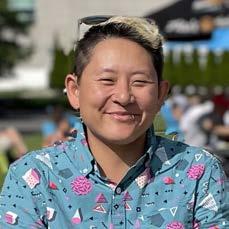
I was born in Korea before I was adopted and raised in a small town in New York State called Cooperstown, by a white hearing family who don’t sign. I grew up oral, went RIT for undergrad, moved to San Francisco for seven years. I met my wife while I was travelling in Asia during my time volunteering in the Philippines. We have two kids, ages two and four. I’m essentially a full-time mom, though I do some part-time research work. I’m working on my thesis which focuses on Deaf Korean adoptees and how they navigate their multiple identities. I hope to continue my work in this field. I hope my thesis will help raise awareness and support of Deaf adoptees, especially transracial and transnational adoptees.
I did have a sense of my queerness when I was young, but I didn’t have a name for it. And as an adoptee, I was used to conforming to society’s expectations. Same as being born a cis-woman, I followed those expectations, too. But I was pretty open-minded. I was never against LGBT identity, really. When I met my first girlfriend, I wasn’t resistant. Then I realized looking back, maybe I did feel something at different moments. When I came out, my family was very accepting. It’s interesting. I think that journey was fairly easy. But as a Deaf person, as a person of color? Growing up, we never talked about race. My family knows nothing about Asian culture. They never went to Korea. I did. My family has a strong medical background, so that’s how I grew up with an oral education. I have an adopted brother who works with cochlear implants. So, they hold that perspective. They don’t sign. They expect me to read lips and speak with them, even though I sign with my own family. But I look at my identity through an intersectional lens. I think it depends who I’m with. If an issue comes up, which identity is the most impacted? But they’re all still there at the same time. That’s why I hate it when people say “Deaf first!
40 FEATURE
Important same.” That’s really harmful for those who have multiple marginalized identities.
It’s rare to be in Deaf Asian queer spaces. It’s really great to be in different communities, but it’s hard to find them all in one space. That’s a challenge to me every day. My wife is also Asian and Deaf. So, we have each other. But when I see queer spaces, we almost never see any Asians there. Or queer Asians dating other queer Asians. Or Deaf Asians. We’re the only ones we know. We think about our children too—Asian, CODA, queer spawn. Will they find people who share their experiences? That’s our reality even though we can dream of growing Asian queer Deaf spaces. My family brings me the most pleasure and joy of all. When I got pregnant, people were surprised. They assumed it’d be my wife because she’s more feminine and I’m gender non-conforming. But it proves anything is possible.
Rogan Shannon, 29 (they, them, he, him)
I was born in Alaska, but when I was three months old, my family moved to Washington State where I grew up and have lived my whole life. I still live here. It depends on who I’m talking to, but I identify myself as queer, both in terms of my attraction and my gender. I do a lot of different freelance work, but my main job is as a Deaf interpreter and I mostly work with DeafBlind people.
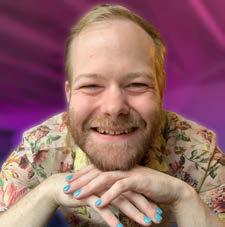
Growing up, my best friend came out in high school, and I thought that was fine. I was surrounded by queer people anyway. But I didn’t think to take a look at myself until I was 20—quite late. Something happened in college, which made me go, “Wait.” Then I went through all the flashbacks. Then it was like, “Wow. That was obvious.” I’d never thought about it because it’d never been a big thing with stigma, and I never thought about how it might impact me personally until I realized I was part of
that community. That was my attraction, however. One or two years later, I started thinking about my gender. But it didn’t take that much time, really— many of my close friends were queer, I was kind of already a part of that community without realizing it. I literally have a picture of myself holding a sign saying, “I am an ally because…” at a Colorfest event at RIT. I took these pictures with my college best friend, and then later we both came out as queer. I still have it in my phone, and sometimes I look at it and just shake my head.
I work at a summer camp for DeafBlind adults. I’m one of the sighted people that guide people around the campground, but the summer camp is just for DeafBlind people. At one point, my client put their hand on another SSP’s shoulder to get some information about them—what they’re wearing, what kind of hair they have, etc.—and afterwards they asked me about the SSP because my client had felt short hair, but the tank straps from a binder, and they weren’t sure what gender that person was. I explained that they were non-binary, and what that meant. But I realized how hard it is to have access to that kind of information in the DeafBlind community, because so much of gender presentation is through incidental learning. So, this is an interesting part of my job, even though I usually don’t even go near my own genderqueer identity at work. I present very masculine and straight—no nail polish, because I’m interpreting, anyway.
In my personal life, I do have to sometimes remind people that I am not cis. That’s why I have a pin on most of my coats with my pronouns, he/they, and they/them. It’s also interesting because with ASL, there aren’t such defined pronouns, either. I really want there to be more ASL resources about different aspects of queerness and queer identity. I don’t see much information in ASL about HIV/AIDs, or different STIs, or medical access like PrEP. Or even explanations of what different illnesses or infections look like—monkeypox is the most recent, and it’s
41 NADmag | Fall 2022 DEAF HUMANS OF PRIDE
been well publicized because anyone can get it—but I still personally haven’t seen any ASL explanation of what HIV/AIDS looks like, for example. Information like that is really important for the Deaf community to have.
Phelan Conheady, 23 (he/they)
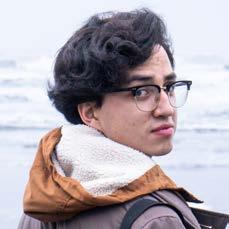
I grew up in Rochester, New York, but just moved to Seattle seven or eight months ago. It’s been a steep learning curve here. I’m most famously known on social media for working at Starbucks, but I don’t work there anymore. I work for a domestic violence/sexual assault association —Abused Deaf Women Advocacy Services (ADWAS) — they’ll be rebranding soon to be more inclusive. I also work as a community trainer, and I give presentations about different topics, such as domestic violence, sexual assault, how to interact with Deaf survivors, healthy relationships, boundaries, and so on. I enjoy it a lot more than pouring coffee. I identify as a queer person. My pronouns are he/him or they/them—I have no real preference, although sometimes when people call me “he” I’m like, “Who? Oh, me.”
I think I knew something was off when I was young and I couldn’t really understand the binary concept, where people were saying it was men and women and that was it. Conceptually I could get it, but emotionally, I wasn’t there. I felt out of sync and couldn’t figure it out until much later when I realized that I was gay. I first identified as a gay male, but eventually I realized that “man” felt like a bit too strong of a word.
I knew I was deaf before I knew I was queer. I grew up in a hearing family. They don’t know sign, and never learned. I also identify as biracial—my dad is white and my mom is Filipino. So, I always knew I would stand out from the crowd. All my friends, classmates, teachers growing up were hearing. I was
mainstreamed, so I already accepted the fact I would be different. Queer just seemed to be another thing to add to that list. I never felt the need to hide it. But I did feel the need to conform in terms of speaking and lipreading. I would say that it was harder to come out as Deaf than it was to come out as queer. I already have family members who are LGBT, so my parents didn’t care. But the more I wanted to sign and the more I wanted to go out with Deaf people, the more they struggled to accept that part of me. In college, I had a big identity shift where I realized I prefer sign, prefer being with Deaf people, prefer Deaf culture. In a way, my Deaf and queer identities were reversed. My parents already had proximity to queerness, but not to Deafness. Whenever I went home, I would have to behave in a different way, to kind of closet myself and turn on my voice and behave hearing. I often joke that I never had a chance to sit down with my parents to come out: “Guys, I’m Deaf.” “No! It’s Adam and Eve, not Adam and Marlee Matlin!”
Allie Joiner, 86 (she/hers)
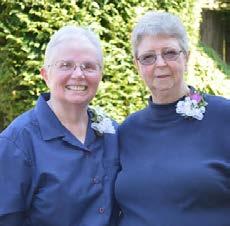
I was born in Arkansas then later moved to Louisiana. I took off to Gallaudet when I was a junior, and came back to pick up my diploma. I was a teacher in South Carolina, New Mexico, and Colorado, then I went to University of Arizona for rehab counseling and met Estie (pictured above) at a workshop in Montana. We ended up in Seattle with an internship in 1971, and before we knew it, we put down roots. I worked as a vocational counselor, then as an advocate at different city projects or organizations, then at ADWAS. I retired at 70 and a half. But then, I started doing some work at the DeafBlind center, and it’s been fourteen years now. I’m a lesbian.
As a kid, I was fixated on getting to Gallaudet— education was number one for me. I was pretty vague
42 DEAF HUMANS OF PRIDE
Photo credit: Cat Cassidy
Estie on the left and Allie on the right.
on my sexuality until I got to college, when I realized about myself that I did like women. I was not out, even though everyone probably kind of knew. It was when I moved to Seattle with Estie that I became bold. I dared anyone to step on my toes. When we moved to Seattle, people would ask how we met or what our relationship was, and I said we were emotionally involved. I never came out then and told people, “I am a lesbian.” Just emotionally involved. That’s it.
When we started getting involved in local Deaf politics like the Washington State Association for the Deaf, I found myself butting heads with the Deaf men in charge of these organizations. I would keep challenging them, asking them questions. Their wives did not like me and Estie. They felt threatened and wanted to defend their own husbands. The first few years in Seattle were rough. But women’s lib happened, and by 1980, we were all getting together regularly. Another important thing that happened when we moved to Seattle was that I wanted to buy a house. I really believe in that kind of security. After renting an apartment in Seattle for a year, we started looking. The realtor was nice to us. Seems like he looked at us as two Deaf women who “helped each other.” He didn’t see us as lesbians. But because Estie’s income as a teacher assistant wasn’t enough, we had to take out a loan. The bank told us to get our wills written up, so we went to a lawyer. The lawyer asked us, “Are you lovers?” I only nodded. Estie wanted to sink under the table. She was mortified. He pulled up some papers. He said, “The first option is adoption.” Estie was shocked. Since I was the older one, that’d mean I adopt Estie. She immediately hated that idea. The second option, the lawyer said, was to get life insurance policies for each other. So, we agreed to get life insurance policies. Then the lawyer told us that was a great decision because he’d already worked with several couples, and adoption was extremely difficult to undo. The life insurance policies all worked out and we got the loan and the house. I still have that piece of paper.
Anja Berens, 37 (she/hers)
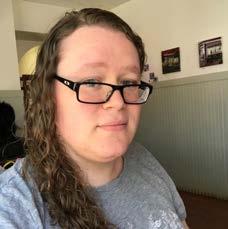
I always laugh when I think of my friend who says, “She grew up on a pig farm.” I didn’t exactly grow up on a pig farm but I’m from a very rural area in Colorado, about 30 minutes from Kansas. My hometown is population 600 people, and it’s probably a town nobody has ever heard of. It’s off the freeway, and was technically one of those small railroad towns back in the day while they were building the railroad. I work at Yelp, I’m a software engineer. I identify as a lesbian. It’s probably a little more complicated than that, but I am a lesbian for all intents and purposes.
I was probably a strange child, honestly! I think the challenge was that I have mild autism, so it’s not always clear which was which and what was what when I look back. I have sensitivity to textures, so I couldn’t wear certain clothes, and I still have a hard time with eating certain foods and so on. My family is a bit untraditional. My parents are both very cis, very het (straight), but they were both from very religious families and hated it, and so when they had kids of their own they decided absolutely no religion for us. They tried their best to raise us without gender norms. So, I knew by middle school that I was not a boy. All the boys talked about things like football or big boobs and I found that so boring and disgusting. But I had no idea what I was. But it’s also not clear because I was also Deaf. My Deaf identity was always the first thing people saw. I do have my quirks as an autistic trans person but people would always see them or comments or things I did as a Deaf thing. In a way, being Deaf shielded me from a lot of other gender issues, because people viewed me as pretty gender neutral at school.
I always said, “I am me, period.” I could have probably continued my life as it was at that point
43 NADmag | Fall 2022
but what kind of broke me was how people— mostly straight people—can be very obsessed about conforming to gender behavior. In college, since I was interested in girls, and people viewed me as a boy, people thought I was straight. But it was a lesbian interest, not a straight interest, and it’s different. Girls I dated were confused by me because I would treat them like a lesbian woman—very open and communicative and affectionate. But they expected me to be manly and protective of them. Because I grew up with almost no social skills, I didn’t know how to introduce myself, I didn’t know how to do many things. It was kind of a baptism by fire, and it was pretty traumatic. After college I sank into a deep depression for about ten years until I tried to kill myself, and then I said, well, maybe I should take hormones. And it worked.
Kent Vance, 33 (he/him)
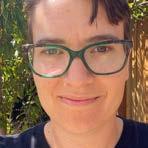
My nickname is K’Challa, after Black Panther. I love the comics, and I loved them growing up even before the movies came out. My birthname is Khalvin Edmond. Long story short, my first name is Kent but it got changed after my family found out I was Deaf. My mom is a CODA and she got really excited and wanted to change my name to something fancy to celebrate, so she changed it to Khalvin. But now I’m reclaiming Kent, because it feels more like me, and less like special treatment just because I’m Deaf. I was born in Oakland, grew up in Vallejo, moved to Hayward when I was twelve, went to Riverside for college, then back to the Bay Area, and I’m in Hayward now. I work at Deaf Plus Adult Community (DPAC), in Newark, near Fremont. I also work at a group home with DeafBlind clients with developmental disabilities. I’m the only Deaf person who works in this group home so I facilitate a lot of communication and follow up with their needs and so on.
I would say I’m gay queer. I’m generally attracted to men, but occasionally I will get together with studs, for example. I’m very open. So gay/queer feels more accurate to me. I’ve always known about myself as long as I can remember. But it was high school that I got really close with a person who was openly gay, and I could see myself in his world. That was the main turning point, when I was fourteen. I’ve got my own chosen family who are my main support system. My biological family’s better now, but when I first came out they were not supportive at all because of their religious background. I have family members who are queer, themselves, too. When I was 21, I moved to Riverside for college—that was when I really came out and got involved in the queer community. I was so excited and was making up for lost time—I went everywhere. I went to West Hollywood (WeHo) in LA, and I took over the queer area of Riverside. I went nuts. Now that I’m a bit older, I take it a bit easier. I do like going out every now and then, but not as much as before. San Francisco and the Bay Area are really safe for queer people, so it doesn’t feel like that big of a deal— basically everyone here is queer, even in Fremont! I have a lot of queer colleagues. My boss is queer, and some of our clients are, too. We don’t really talk about it that much, but everyone just kind of knows and goes with the flow. My real advice is to live your own truth. Be happy with yourself, whatever your journey is. Whether you’re out or not, just know that it’s ok to be who you are and to take your own time.
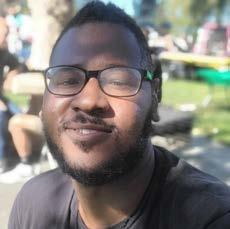
44 DEAF HUMANS OF PRIDE
Ariel Baker-Gibbs (she/hers) is a Deaf writer and graduate student living in the Bay Area.
DONOR LIST
The list below recognizes donations made by individuals and organizations to the NAD from August 2021 – March 2022. Donors are listed under the designated fund. If a fund is not designated, donors are listed under the general fund. Individual donors are recognized by their level of giving. Organizational donors are recognized by their member type. Individuals and organizations who are not members are listed as friends of the NAD.
There is a Donor Key on the right for individual giving levels and organization member status. Roman numerals following Benefactors (B) identify cumulative donation amounts in $1,000 increments.
Bequest
The NAD expresses great appreciation for the generous bequest from:
The Estate of Gertrude E. Kortan
The Estate of Stewart and Rochelle Grill
Annual Fund Campaign –General
Lori Adams, A Andrew Adler, C Daniel Adler, FON Tomer Aharoni, S Taye Akinola, A Peter Allen, FON Isabelle Altman, FON Suzanne Amaral, FON Carl Anderson, S Glenn Anderson, P
Theresa Andrezywski, FON Anonymous, FON Luisa Antoniello-Westfield High School, FON Margaret Arnold, A Stephanie Aronson Hightman, FON
Glenna Ashton, BVII
Caroline Assumpcao, FON
Danielle Ayres, FON
Koren Baker, FON
Steve Baldwin & Rosie Serna, Bl Dallas & Margaret Barker, BIII
Vanessa Baxter, A Timothy Beatty, BIII Roberta Beckman, FON Brian Bedoya, FON
Suzann Bedrosian, BI Linda Bellew, FON
Mokhtar Bensaker, FON
Paul Bert, S
Kim Bianco Majeri & Chris Majeri, BIII
Kevin & Sandra Bianco, P Jane Biehl, A Michael Bienenstock, P
Marcos Blaha, FON Sarah Blattberg, BI
Cheryl Blue, A Alyson Boote, S
Sarah Bortz, FON Michael Bourcier, BI Emil Bova, FON Mary Boxer, BI Renee Bragg, FON Philip & Judith Bravin, BXIV Seth Bravin, BII
Amanda Bray, A Randy Breeden, A Roberta Bregstone, FON Jinny Bromberg, FON Jeanette Brossmann, A Cindi Brown, P Eleanor Brown, A Roger Brush, BI Jenny Buechner, BII Frank Burckardt, P Robin Burgess Mack, A Matthew Burke, FON Jackson Busenbark, A Mirtha Castellano, FON Xavier Caylor, A Jean Celestin, FON
Howard Chabner, P Deedee Chavez, FON Ayoung Cho, FON Nancy Chough, BlV David Cid, FON Kyle Amber Clark,C Michelle Cline, BI
Ed Cohen, BIII
DONOR KEY
B = Benefactor ($1,000 and up)
P = Patron ($500-$999)
S = Sustaining Member ($250-$499)
C = Contributing Member ($100-$249)
A = Advancing Member (up to $99)
SA = State Association Affiliate
FON = Friends of the NAD
OA = Organizational Affiliate
Rosalie Cohen , FON Linda Colon, FON Platte Color, FON Raymond Conrad, P Nina Corbin, FON John Corrill, FON Harvey & Mary Ann Corson, BXXV Kaleb Crouch, FON Michael D’Angelo, FON Pamela D’Occhio, S Ethan Daniels, FON Tivia Darden, FON Sumner Davenport, A Seth Decoteau, FON Jennifer Demiter, FON Marisa Dempfle, FON Valerie Dively, P Ala Dorvil, FON Alok Doshi, BI Daniel Dowding, FON Michael Dowds, C Melissa Draganac Hawk, BXX Eric & Linda Drattell, BII Audrey Duff, FON Kendall Dunlap, FON Joyce Dworsky, P Lisa Dyas, FON Peter Eisenhauer, FON Kingsley Emelike, FON Christine Fairbank, FON Susan Faustini, FON Elizabeth Fazzolari, S Stephanie Feyne, S Aaron Finestone, FON Megan Floyd, FON Andy Foster, S Raymond Francini, A Steven Frank, BI Alice Ann Friends, S
Irene Garcia-Benavides, A Donna Gateley, S Haya Gaviola, FON Andrew Gehling, FON Sean Gerlis, BlV John Godich, Bl Jane Golightly, BIII Ariadna Gonzalez, FON Edward Gonzalez, FON Harvey & Astrid Goodstein, BXXVIII
James Gordon, P William Rann Gordon Jr, BIV Debra Gorra Barash, A David Graff, FON Esther Griffin, P Adam Grijalva, FON David Grocki, A Alice Guilbert, BIV Nicole Gustafson, FON Richard Hall Jr., S Vicky Hamrick, FON Denise Hanlon, BVII
Thomas & Kathryn Harbison, Bll Michael Harder, A Judy Harkins, BI
Jessica Harnly-Cooper, A Ray Harris & Rachel Stone, BlV
Raymond Harris, FON Robert & Evie Harris, BXI Amelia Hart, C J. Hauxx, FON
Mark Heflin, C Michael Henderson, S Robert & Patricia Herbold, BII Carol Hilbinger, A Robert Hoffmeister, BI Tom Hohmann, FON
45 NADmag | Fall 2022
Thomas Holcomb & Michele Berke, BII
Pamela Holmes, BIII
Karen Holte, BlV
Jaclyn Holsomback, A
Justin Honard, FON
Katherine Hubbard, FON
Charles Hubbs, FON
Cy & Cathy Hufano, FON
Scott Hull, FON
T. Alan & Vicki
Hurwitz, BXXVII
Amanda Innes, FON
Lorna Irwin, BIII
Traci Ison, S
Ivanito, FON
Caroline Jackson, BI
Margaret A. James, BI
Christopher Jennison, FON Rae Johnson, BVI
Vilas Johnson Jr, BXI
Gabrielle Jones, C
Gillian Jordan, FON
Alexis Kashar, BVIII
Elizabeth Katz, FON Mary Keane, A
Aaron Keigher, FON
Nikolas Kelly, A
Dorothy Kelsay, BIV
Judith Kidman, FON
Laura Kim,A
Sho Kimura, FON
John Kirsh, BI
Darcy Knight, FON
Laura Koons, FON
Rajashree Kotejoshyer, FON
Donald Kovacic, P
Lee & Bonnie Kramer, BVII
Karen Kunkler, S
MaryLynn Lally, S
Alan Lam, FON
Daniel Lasher, A
Kathryn Laughlin, FON
Jeanne Lavelle, BII
Rhoda Lea, FON
Yuan Ci Lee, FON
Kylie Leverette, A
Mitchell Levy, P
Savannah Little, FON
Glenn Lockhart, BII
Matthew Lockhart & Julie Bourne, BV
LaDonna Love, A Nhu Luong, FON Elaine Ma, FON Aidan Mack, S
Gina Mahoney, FON
Deborah Makowski, S
Judith Malmberg, FON
James Manning, FON
Fnu Manu Murali, FON Amber Martin, A
Sylvia Martinez, FON Trell Mason, FON
Sarah Mathews, FON
Tina Mathews, FON
Susanne Matlin, FON
Biana Mavasheva, FON
Tiffany May, FON
Pat McCullough, P
Michael McKee, FON Betty McKown, BV
Kathryn McLaughlin, FON
Brian McMahon, P
Walter McQuillan, FON Lewis Merkin, BI Kenneth Mikos, BXII Barbara Miller, P Jean Miller, A Lucy Miller, BXXIII
Marvin Miller, P Robin Mills, BI
Jolie Mintz, Fon
Rachel Miura, FON Elisa Mlynar, C
Abdulazeez Mohammed Salim, FON
Jason Monkarsh, FON Samantha Moore, A Ruth Moore, BII
Milmaglyn Morales, P Reyna Moran, C
Terry Morrell, S Bob & Barb Morry, FON Jason Morris, FON Judith Mounty, BIII Harold & Mary Mowl, BX Geri Mu, BI
Brendan Murphy, S Susan Murray, FON Grace Musumeci, FON Mitra Naeimi, FON
Tiffany Nguyen, FON Nancy O’Donnell, C Kathleen O’Regan, C Jay Osche, FON
Elizabeth Owens, FON Melba Padilla, FON Louis Parnes, FON
Melissa Patronella, FON James & Susan Pedersen, BXXXVI
Ariel Dario Perez, FON Brian & Faith Perry, BIII
Klaudia Persson, FON David Phillips, BI Stacey Pollard, P James & Kathy Potter, BVII Michael Provancha, FON Larry Puthoff, Bll Arvilla Rank, BIII Khadijat Rashid, BI Jason Redlus, FON Anthony Regno, FON Jeffrey Reisenberg, FON Karthik Repala, FON Andrea Richards, A Tiffany Richardson, FON Kelly Richter, FON Barbara Rick, A Timothy Riker, S Janice Rimler, P Jason Rioux, FON Paul Robertson Jr., BI Dara Robinson, FON Stephanie Robinson, A Joseph & Kay Francis Rose, BVll Dan Rosenblatt, A Howard Rosenblum, BXXVI Lore Rosenthal, P Nicholas Ross & Heather Kelly, FON Nicole Rowse, FON Helen Royal, FON Patricia Saar McFadden, A Michael Sakoff, FON Deborah Sampson, P Kathy Say, BI Lisa Schindele, FON Cheryl Schmidt, S Elena Schoonmaker-Gates, FON Daniel Schreiner, BIV Kimberley Scott-Olsen, A Amber See, FON Abby Self, FON Tanvi Sengupta, FON Amanda Shi, FON Nancy Shugart, Bl Jerry Siders, BI Pamela Siebert, BI Charles Silva, FON Toby Rae Silver, BI Julia Silvestri, A Paul Singleton & Suzy Rosen Singleton, BV Marilyn Smith, BVIII David Snyder, FON Marcia Solomon, FON Glenda Stamper, FON Ronald Stern & Hedy Udkovich Stern, BII
Vicky Stockton, A William Struthers, FON Mark Sullivan, BI
Mark Summers, S Stavros Sumner, FON
Christopher Susek, FON Marilyn Swanson, FON Lizette Tannebaum, FON Lauren Tappana, FON Hartmut Teuber & Janice Cagen Teuber, BIII
Kittipong Thaothong, FON Diane Thorpe, Bl
Kirby Tibbit, FON Agnes Tiffon, FON
Tricia Tighe, S Filip Tomic, FON Topsy Toner, A
Pedro Torres-Salgado, FON Brenda Tress, S
Billy Truong, FON
Heather Turell, C
Alyssa Urban, FON
Betty Van Tighem, BXVI Nancy Varga, FON Kasey Vessel, C Gary Viall, Bll
Frans Victorious, FON Maxim Vikonski, FON Christian Vogler & Krystallo Tziallila, BII James Volosin, FON
Michael Wallace, A Susan Wallace, FON Ying Chih Wang, FON Kellyn Warne, FON Daniel Waters, FON Maxwell White, FON Richard Whitehead, FON Sharon Wiegand Sinkler, BI
Jeffrey Wiessinger, FON Lisa Williams, FON
Stephen & Melanie Williams, BIII
Sara Winchester, BI
Alan Winegard, P Lisa Wirkus, A
Betty Witczak, BIII
Barbara Wood & LaWana Clark, BX
Rebecca Woodruff, FON Tyese Wright, P Cheng Xi, FON Rieko Yajima, FON
Michelle Yerkin, FON Davorka Zeba, FON Dan Zigmond, P
46 DONOR LIST
Amazon Smile Foundation, FON American Charities, FON Angelus Corp., FON Articulate Global, FON Benevity, FON BGE, Ltd, FON
Case Western Reserve University Chapter CNA Center, FON Facebook Donations, FON Friday’s Films, FON Galaxy Gaming, FON Hewlett Packard Employee Volunteer Program, FON IBM Employee Service Center, FON
Laurence W. Levine Foundation, Inc, FON Make The World A Better Place, FON NBC Universal Employee Resource Group, FON Network For Good, FON Renaissance St. Louis Airport Team, FON Rosen,Bien,Galvan & Grunfeld, LLP, FON Ultratec, Inc/Captel, Inc, OA Wagers Family FundCommunity Foundation, FON Your Cause, FON
Melissa Mittelstaedt, A Frank & Marlene Turk, BXVII
Annual Fund Campaign –Education Advocacy
William & Lori Barnwell, FON
Adelaine Belford, FON Steph Buell, P
Kristina Couden, FON Rodney & Vicki Danco, BV
Ala Dorvil, FON
Michael Forrester, FON Christine Green, FON
Stephen & Tawny Hlibok, BVI
Jazzy Jones, C
Amanda Liddy, FON
Funmi Odutayo, FON
Glenda Stamper, FON
Christopher Susek, FON
Kittipong Thaothong, FON Wendy Wagner, FON Amy Williamson, P
Joseph Sapienza, BII J. Matt & Susan Searls, BII Jerry Seth, BI Roger & Connie Smedman, P Glenda Stamper, FON Natalie Van Eman, BIV Nicole Voltz, FON Bruce & Barbara White, BVI Melanie Williams, BIII Sharon Wilson, P Wanda Witczak, FON Rosen,Bien,Galvan & Grunfeld, LLP, FON
William & Lori Barnwell, FON
Thelma D. Baro’s Birthday
Shari Madrigal, FON
Eleanora Belford
Adelaine Belford, FON
Melissa Beyer Coate’s Birthday Lori Reese, FON Taylor Bierbrodt’s Birthday Christine Peel, FON
Ebbi Blockum’s Birthday
Annual Fund Campaign –Youth Leadership
Steven Danklef, FON Nikolas Szabo, FON
Annual Fund Campaign –International
Carol Duffy Clay, A Kathleen Montague, FON
Annual Fund CampaignLaw and Advocacy
Nancy J. Bloch Leadership & Advocacy Scholarship
Margie Bridges, BII Ala Dorvil, FON Anita Farb, BXI
Alice Ann Friends, S Lisa Furr, BI Steve Lovi, BI
Terry Maier, A Grace Musumeci, FON Jerry Nelson & Nancy Bloch, BLV
Christopher Wagner, BXV Barbara Wood & LaWana Clark, BX Joseph Zimmerman, FON
Frank R. Turk Youth Leadership Scholarship
Ala Dorvil, FON
Alice Ann Friends, S Lisa Furr, BI
Joseph Amuso, A Emmanuel Azodeh, P Gerard & Judith Buckley, BXVII
Steph Buell, P
Gene Deetz, FON
Ala Dorvil, FON
Thomas & Laurie Dowling, BV
Charles Fraenkel, FON Harvey & Astrid
Goodstein, BXXVIII
Norman & Catherine Ingram, BVII
Judy Jonas, C
Krystel Jones, A Elizabeth Leisure, BI
Kylie Leverette, A
Jill Moebus, A
Sharon Morency Bryant, BVIII
Julie O’Brien, S Kristine Pagano, BI Breeanne Patrick, FON
Carrie & Joe Regenstein, FON
Kim Bianco Majeri & Chris Majeri, BIII Lizzie Bloom, BI Ayla Clark-Matta, FON Karen Copeland, FON Joyce Crim, FON Katie David, FON Ala Dorvil, FON Mary Dunn, FON Jan Fried, A Donald Galloway, BII Karen Gropp, FON Charles Katz, A Patricia Kuglitsch, BIII Christopher Loflin, FON Gary Olsen, P John Powell, FON Glenda Stamper, FON Kittipong Thaothong, FON Jennifer Yost Ortiz, P Giving Tuesday, FON
In Honor…
Chris Alestra’s Birthday Gia Gilk, FON Roxanne Vialpando, FON
Alisa’s Birthday Sue Donegan, FON
Christina Baker’s Birthday Christina Baker, FON Dawn Fouts, FON Desirae Schreiner, FON
Bill Barnwell & Erin Timperlake’s Wedding Dale & Nancy Adler, FON Daniel Adler, FON
Chuck Borcher’s Birthday
Lester Arguelles, FON
Bart Badsing, FON Jay Blumenfeld, P Chuck Borchers, C Sophie Borchers, FON
Kathy Johnson-Dmochowski, FON
Leslie Speicher, FON Rikke Vognsen, FON
Gina Brengs
Amanda Liddy, FON
Jonathan Bryan John Powell, FON
Jenny Buechner’s Birthday
Ken Arcia, S
Anthony Barraza, A Jenny Buechner, Bll Gale DeArmin, S Mary Dunn, FON
Lindalu Fox Wheeler, A Karla Gunn, S Tim Mumm, FON Cuong Nguyen, FON Jim Powell, FON
Andrea Schneider, FON Carol Wagner, FON Peggy Weaver, BI
Jenny Buechner’s Giving Tuesday
Joyce Crim, FON
Katie David, FON Mary Dunn, FON Karen Gropp, FON
47 NADmag | Fall 2022
DONOR LIST
Henry Burns Johnson’s Birthday
Conner Howell, FON Emily Johnson, FON Robin Johnson, FON
Dave Byrd
Helen Royal, FON
Juanma Chicharro
Elena Schoonmaker-Gates, FON
James Christianson’s Birthday
Julia Almeida, FON Karen Atwood, C
James Christianson, C Philena Gordon, FON Steve James, FON Samuel Ruiz, FON
Erin Shaughnessy, FON
Judith Shaughnessy, FON
Marla Simon Bronstein, FON
Lisa Stoner, FON Conrad Strack, A
Robert Clark’s Birthday GarKat Clark, FON
Sarah Curry’s Birthday
Sarah Curry, FON Linda Nelson, BI
Alyson Rose Daly Betty Zimmerman, FON Luci Danish’s Birthday Abigail Burk, FON Marjorie Sandberg, FON Deaf Business Mark Sullivan, BI
Sriyyah DeBose’s Birthday Sriyyah DeBose, FON Gina DiNicola’s Birthday Mona Cedar, FON
Tim & Mary Donovan
Conrad & Abby Myers, FON Debbie Downey
Bobbie Faye Downey, A
Melissa Draganac-Hawk’s Birthday
Lizzie Bloom, BI
Frank Lee Durnell’s Birthday
Paula Home, FON Clem Jennings, FON Lisa Jones, FON Yvonna Eaton’s Birthday Yvonna Eaton, FON Wendy Hand, FON Amber KingeryGordon, FON Lutke, FON
ExeosCraft
Mark Doyle, FON
Jason Fairall’s Birthday Margie Sutton, FON
Trevor Ferrand’s Birthday
Curt Bingman, FON Erin Ferrand, FON Trevor Ferrand, FON Damien South, FON
Michael Fick’s Birthday
Cheryl Keller, FON Geraldine Francini’s Birthday Joseph & Kay Francis Rose, BVII
Amie Franklin’s Birthday
Emma Tanner, FON Ashley Gailliot Roach’s Birthday
Tianna Crawford, FON Matt Froelich, FON James Gailliot, FON Ashley Gailliot Roach, FON
Debra Galindo-Salazar’s Birthday
Judy Becker, FON Sharon Bush, FON Debra Galindo-Salazar, FON Karen Karlik, FON Mallisa Rivette, FON
Amber Gaver’s Birthday
Alex Dinh Menh, FON Shannon Johnson, FON Lisa Statz, FON
Dawn & Bruce Germann
Michael Provancha, FON
Kayleigh Geyer’s Birthday
Beth Gross, FON Lucas Christopher Greene’s Birthday Nora Hardy, FON
Jane Greer’s Birthday Katherine Huber, FON Carol Kent, FON Jane Greer, FON Kenny Hack’s Birthday Daniel Capote, FON Jeff Compton,FON Trevor Jones, FON Nenita Linton, FON Shideh Shahideh-Doerr, FON Christina Smith, FON Allan Stam, FON
Judy Hall Collin’s Birthday
Jill Meich, FON Sara Rast, FON Olivia Hamblin’s Birthday Tiffany Ahrens, FON Nanette Waddilove, FON
Louise Hamer Peter Eisenhauer, FON
Patrick Harris & Daniel Lisa, Chris,Connor, Emma & Percy
Rob Hewitt’s Birthday Kate Cullifer, FON Rob Hewitt, FON Lewen Myers, FON Ken Stoeffler, FON
Andrew Holbrook Mr. Holbrook, FON
Mayra Faria Huguenin’s Birthday Mayra Faria Huguenin, FON Neusa Malves, FON
IS2 Class 621: Danielle, Katie & Raymond Linda Colon, FON
Austin Isaac’s Birthday Terri Bowman, FON
Erica James Foster’s Birthday
Nathen Callahan, FON Van Williams, FON
Bryan Jeffcoat’s Birthday
Bryan Jeffcoat, FON Parkash Subedi, FON
Alan Jeffer’s Birthday Jamie Rae, FON
Kim Jefferson’s Birthday Kim Jefferson, FON
Cindy Johnson Navin’s Birthday
Sue Williams, FON Alex-Scotty Jones Birthday Kenley Holbrook, FON The Meldrums, FON
Robert Allan Jones Krystel Jones, A
Helen Keller Wendy Williams, FON
Laura Kim’s Birthday
David Hegarty, FON Melissa Herzig, C RM Hoy, FON Caitlin Hunt, FON Myung Sook Kim, FON Carole Piccirilli, FON Liz Stout, FON Julie Troalic, FON Grace Waring, FON Susan Waring, FON
Matthew Kinig’s Birthday
Michelle DevotoOroho, FON Christine Harvey, FON Richard Hausman, FON Patricia Smith, FON
Amanda Leann’s Birthday
Amanda Leann, FON
Jacob Leffler’s Birthday
Tina Jacobs Joyner, A
48
Pamela Minister Logan
Mackerl’s Birthday
Polly Brekke, FON Sharon Grayer, FON Pamela Mackerl, FON
Maggie Mahoney
Gina Mahoney, FON
Carol Mantsch
Jeffrey Reisenberg, FON
Susanne Matlin’s Birthday Susanne Matlin, FON
June McMahon’s Birthday
Heath Alter, FON MJ Bienvenu, P Thomas Holcomb & Michele Berke, BII Harold Levy, P Morag MacDonald, FON June McMahon, BIII Martha Mnich, FON Ruth Moore, BII Herb & Roslyn Rosen, BXXXVI Fatima Silvestre, FON Samuel Sonnenstrahl, BI
Elise Miguel’s Birthday
Jeanne Abbruzzese Thomas, FON JoAnn Costelloe, FON Susan Costelloe, FON Krysta Mills Birthday Rebecca Chwirut, FON Krysta Mills, FON Marion Worrell, FON
Antonio Mitzin Cati’s Birthday Ariana Thomas, FON
Winchell Moore’s Birthday
Richard & Luisa Soboleski, BI
Milmaglyn Morales Birthday
Marie Coppola, A Farah Espinosa, FON Christopher Hayes, A Ry Mitchell, FON Ron Pasch, FON
Valerie Morrison’s Birthday
Wiliam Evans, FON Bette Rosenthal, FON
Mariah Morse’s Birthday
Bronwyn Nettles, FON Judith Turner, FON
David Mthomas Birthday
Jennifer Kneessi, FON Jennifer Sheats, FON Jim Thomas, FON Josie Thomas, FON
Denis Munn’s Birthday Joseph & Kay Francis Rose, BVII
National Youth Day Sarah Herrlinger, FON
Steve Near’s Birthday Stacie Near, FON Sue Near, FON Joyce Wigner, FON
Brandy Nicole’s Birthday Melissa Hastings, FON Brenda Mace, FON Libby Mace Shriver, FON Brandy Nicole, FON Desi Shriver, FON Patsy Stoots, FON
Mary Nkafu’s Birthday
Susan Baker, FON Ruth Ilabor, FON Vivian Labarca, FON Gabrielle Tayac, FON
Ronald Emery Nomeland’s Birthday
Heather Babula, FON Kay Burrhus, FON Laura Pohl, C Julian & Bernice Singleton, BVlll
Takuma Ota’s Birthday
Mike Ansell, FON Tadashi Takaoka, FON
Patricia’s Birthday Dwight Bowman, FON
Scott & Janis Perry Brian & Faith Perry, BIII
Abbie Peterson’s Birthday Luann Kellnar, FON
Sarah Poirier’s Birthday
Cheryl Guilbault, FON Mary Guilbault Barry, FON Gerry Hripak, FON Jeannine LeBlanc, FON Cecilia Poirier, FON
Lisa Radloff Sarah Bortz, FON
Cori Rae’s Birthday Shelby Cherry, FON
Kimberly Ramsay’s Birthday Wendy Carrington, BIII Kris Rs, FON
Skyla Ramsay’s Birthday
Leslie Acuna, FON Sharon Boughton, FON Julie Davis, FON Maureen Ramsey, FON Kerry Tovery, FON
Carola Rasmus 100th Birthday Hilary Ainbender, P Rahul B. Raval’s Birthday Eileen Drewery, FON
Sam Razvi Sam West Syed, FON
Real Talk
Paul Singleton & Suzy Rosen Singleton, BV
Larissa Resende’s Birthday
Chris Ereneta, FON Geri Freema, FON Susan Levasseur, FON Linda Romano, FON Maureen Walsh Bennett, FON
Deysi Rivera’s Birthday
Oracio Rivera, FON Mi Sh, FON
Lisa Rose’s Birthday Mike Bates, FON
James Christianson, C Dianne Hodgins, FON Valerie Kline, FON Bill Riha, BIII Lisa Rose, A Dorothy Schneider, FON Nicole Smith, FON Katie Vetter, FON
Lisa Rose’s Giving Tuesday Lisa Rose, A
Howard Rosenblum Howard Chabner, P Herb & Roslyn Rosen, BXXXVI
Mindy Russo Davis Birthday JoAnn Riggen, FON
Kevin Ryan’s Birthday Paul Costello, FON Tracy Hemmingway, FON June McMahon, BIII Kevin Ryan, BI
Sabrina’s Birthday Debra Del Castillo, FON
Enrique Sanchez’s Birthday Bill Loy, FON
Savannah’s Birthday Makenzie Turcic, FON
Heidi Schneck’s Birthday
Alyssa Naomi, FON Heidi Schneck, FON Tony Schneck, FON Wayne Schneck, FON Dennise Scott’s Birthday Joseph & Kay Francis Rose, BVII
Julia Sellar’s Birthday Stan Sellars, FON Vickie Wintricj, FON
49 NADmag | Fall 2022
DONOR LIST
Warren Snipe
Andrea Potts, FON Sharon Umlauf, A
Spencer Solomon Marcia Solomon, FON
Shoshannah Stern’s portrayal of Eileen Leahy in Supernatural Isabelle Altman, FON
Super Bowl Performances Kristine Pagano, BI
George Swanson’s Birthday
Dee Hospodarsky, FON Kris Kelley, FON Al & Connie Lipka, FON Kris Pokorney Walter, FON Jerry Potter, FON Kim Schminke, FON George Swanson, FON Mark Walter, FON Jimages Young, FON Daniel Tamburello’s Birthday Lewis Bryson, FON
TFS Sunshine Katherine Hubbard, FON
Gloria Tiberi’s Birthday Doug Jackvony, FON
Rebecca Tillero’s Birthday
Alan Greene, FON Ginny Love, FON Stephanie Payntor Puglise, FON Todd Stark, FON Rebecca Tillero, FON Bobby Wilson, FON
Thomas Totten Jr’s Birthday
Mary Corsetto, FON Lisa Nicholson, FON David Ray, FON
Annette Tuck’s Birthday
Deanna Budzynski, FON Gabe Tunstall’s Birthday Julie Schneider-Powell, FON
United We Stand
Ala Dorvil, FON Alice Ann Friends, S
Grace Van Note’s Birthday
Jane Glick-Coleman, FON Maria Romero Luther, FON
Virtual YLC 2021
Amy Anderson, FON
Carlos Aponte-Salcedo, A Karen Atwood, C
Anthony Barraza, A Ny’kel Best, A
Kim Bianco Majeri & Chris Majeri, BIII
Lizzie & Carrie Lou Bloom, BI Becca Brenowitz, A Esther Brenowitz, FON Richard Brumberg, FON Jenny Buechner, BII Michelle Cline, BI Jean Davis, C Deniz, FON Tri Der, FON
Melissa DraganacHawk, BXX Laurel Dunlap, FON Sara Fair, A Shane Feldman & Julie Tibbitt, BIII Feta Fernsler, A Claudia Foy, S Daniel Girard, P Steve & Janet Girard, FON Stephen Gits, FON Chanel Gleicher Bonheyo, C Amy Gomme, S Karla Gunn, S Stephanie Hakulin, A Steve Hamerdinger, BIII Amelia Hamilton, A Nancy Haug, C Bryan Horch, A Peggy Huber, C
Lourdes Jackson, FON Katherine Jankowski, BIV Alesia Jaramillo, A Emily Johnson, FON Helen Johnson-Peterson, BII Chris & Erika Kaftan, A Ann Land, FON Alicia Lane, P Anne Leahy, C
Sarah Leathers, FON
Jacob Leffler, S Anna Lynch, C Melissa Malzkuhn, P June McMahon, BIII William Millios, BI Philippe Montalette, BV Milmaglyn Morales, P Jeff Mosher, FON Joan Ostrove, C Gloria Pagan, S Debra Patkin & Tayler Mayer, P Kirsten Posten, BIII Allie Rice, S Anna Maria Rinaldi, BI Alina Rosas, A Howard Rosenblum, BXXVI Kevin Ryan, BI Jim Skvorak, P Alana Smith, A Briana Smith, FON Caitlyn Smith, C Alfred Sonnenstrahl & Irene Leigh, BVI Wanda Swift, FON Tricia Tighe, S Deanna Tilden, C Jose-Ovi Velasquez, C Miako Villanueva, S Melanie Williams, BIII Sharon Wilson, P Jimel Wright, A
Lawrence Weikum’s Birthday Kelly Richter, FON
Alexandria Wick’s Birthday
Christy Albright, FON Peggy Arensdorf, FON Cheryl Ferguson, FON Margaret Lenk, FON Patty Vance-Lueck, FON Kathleen William’s Birthday Barbara Adde, FON Suzanne Hite, FON Sharon Mattis, FON Stacy Shore, FON Alicia Windisch’s Birthday Ashley Leonard, FON Ethel & Ray Winters Linda Bellew, FON
In Support…
DeafBlind Section
William & Lori Barnwell, FON
Renee Bragg, FON Ashlee Cain, FON
Ala Dorvil, FON Alice Ann Friends, S Lynn Hajdu, FON
Christian Jankowski, FON William & Sheryl Lucas, FON Jason Redlus, FON Tanvi Sengupta, FON Glenda Stamper, FON Christopher Susek, FON Kittipong Thaothong, FON
Deaf Culture & History Section
Renee Bragg, FON Ala Dorvil, FON Bobbie Faye Downey, A Alice Ann Friends, S Janet Parker, A Kerry Sousa, FON Glenda Stamper, FON Kittipong Thaothong, FON David Windham, FON
NDEC/Education Section
Renee Bragg, FON Ala Dorvil, FON Tanvi Sengupta, FON Glenda Stamper, FON Christopher Susek, FON Kittipong Thaothong, FON Amy Williamson, P
Interpreter Section
Danielle Ayres, FON
Renee Bragg, FON Ala Dorvil, FON Alice Ann Friends, S Janet Parker, A Glenda Stamper, FON Christopher Susek, FON
Lesbian, Bisexual, Gay, Transgender Section
Renee Bragg, FON Ala Dorvil, FON
50
Glenda Stamper, FON
Cynthia Tiger, A
Senior Citizens Section
Renee Bragg, FON
Ashlee Cain, FON
Ala Dorvil, FON
Thomas & Laurie Dowling, BV Cy & Cathy Hufano, FON Grace Musumeci, FON Janet Parker, A Nancy Rarus, BXV Roger & Connie Smedman, P Glenda Stamper, FON
Youth Leadership Section
Renee Bragg, FON
Ashlee Cain, FON
Kristina Couden, FON
Ala Dorvil, FON
Jan Fried, A Donald Galloway, BII
Amanda Liddy, FON
John Powell, FON Jeffrey Reisenberg, FON
Glenda Stamper, FON Sam West Syed, FON Jennifer Yost Ortiz, P
Beverly A. Dankert
Kathleen Krieger, FON
Lynn Hajdu, FON
The Angelus Corp., FON
Patrick Debesa
William Broome, FON
Michael Thor Eisele
Charles Katz, A
Arlene Finkelstein
Marilyn Finkelstein, FON
Nancy Gallagher
Thomas Gallagher, BI
Rose Grossman
Peter Allen, FON
Phyllis Head
Jean Busch, FON
Charles Fraenkel, FON
Kathleen Montague, FON
Alexander Wolcott, FON
Edie Hotchkiss
Pat McCullough, P Wanda Hull
Lynn Null, BVII
Helen Jackson
Caroline Jackson, BI
Billy Kekua
Jan Fried, A
Peggy Lawson
Lillie Cost, FON
Parker Grant Nelson
Ron & Betty Backes, FON Susan Elliott, BI Karen Newton, FON Jerry Nelson & Nancy Bloch, BLV
Elissa Olsen
J. Matt & Susan Searls, BII
Virginia Robinson
Kristina Couden, FON Richard Rooney Jolie Mintz, FON
Judy Kay Russell
Roberta Beckman, FON Christian Sheffer
Suzanne Lemka, FON Christa I. Shiffer
William Sousa
Kerry Sousa, FON
Arlene Walfish
William & Sheryl Lucas, FON
Carrie & Joe Regenstein, FON
Howard M. Watson
Darlene Watson, BIV
James & Dorothy Wiegand
Sharon Sinkler, BI
Jack & Jerry Winters
Linda Bellew, FON
In Memory...
Wilhelm Bartenbach
Martha Bartenbach, FON
Del Bellew
Linda Bellew, FON
Jim Boardman
Pat McCullough, P
Stephen Brenner
Joyce Dworsky, P
Frederick M. Cardenas
Maurice Cardenas, FON
Raylyn Carlson
Tiffany May, FON
Dana Cinelli
Rachel Miura, FON
David Copeland
Karen Copeland, FON Luann Copeland, FON
Barbara Kannapell
Elizabeth Weyerhaeuser, BIV
Karen Garofallou, FON Zenith Gladieux, FON Shawna Lambert, FON Brian & Susan Melick, FON Norman & Janice WehrenNissen, FON Ed & Dottie Young, FON
IN MEMORIAM
James Boardman, Sustaining Member
William Brown Jr., Patron
Raylyn Carlson, Friend of the NAD
David Copeland, Advancing Member
Janice Durkaj, Friend of the NAD
George Dyess, Sustaining Member
Larry Evans, Benefactor I
Elmer Ewan, Patron
Robert Firestone, Sustaining Member
Nancy Gallagher, Benefactor I
Jack Gannon, Benefactor XI
William Gulley Sr., Benefactor IV
Wanda Hull, Benefactor II
Kenny Hynes, Benefactor III
Helen Jackson, Friend of the NAD
Alan Karp, Sustaining Member
Billy Kekua, Advancing Member
Jan Nishimura, Benefactor I
Orville Northcutt, Sustaining Member
Elissa Olsen, Sustaining Member
Luther “Bill” Prickett, Advancing Member
James Revell, Benefactor III
Virginia Robinson, Advancing Member
Wayne Shook, Friend of the NAD
Adele Shuart, Patron
Barry Strassler, Sustaining Member
David Wise, Benefactor I
51 NADmag | Fall 2022
8630 Fenton Street, Ste. 820 Silver Spring, MD 20910
52













































































































 BY ARIEL BAKER-GIBBS (she, hers)
MJ Bienvenu, 69 (she/hers)
BY ARIEL BAKER-GIBBS (she, hers)
MJ Bienvenu, 69 (she/hers)







